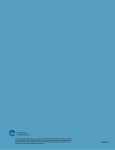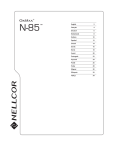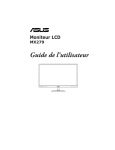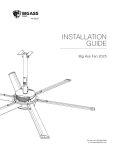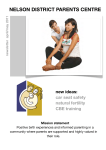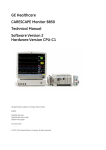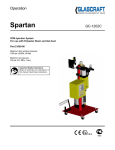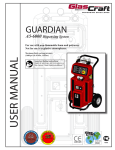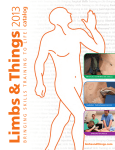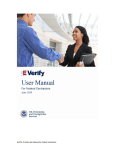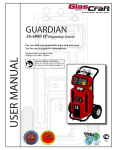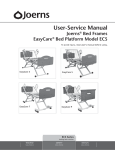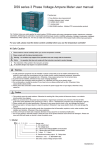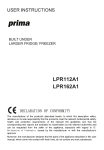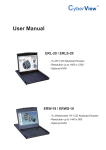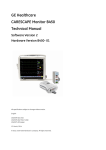Download F Cost of setting up newborn care corner
Transcript
1 SOP
Background
%DQJODGHVKKDVPDGHVLJQL¿FDQWSURJUHVVLQFKLOGVXUYLYDOGXULQJWKHODVWGHFDGH8QGHU¿YHPRUWDOLW\KDV
declined remarkably in recent years and Bangladesh is on track to achieve Millennium Development Goal
(MDG) 4 for a two-thirds reduction in child mortality by 2015.
Despite this encouraging trend, high rate and slow declines in neonatal mortality is one of the major concern
for child survival and challenge for sustaining progress towards achieving MDG-4. An estimated 100,000
QHRQDWHV GLH HDFK \HDU LQ %DQJODGHVK ZKLFK DFFRXQWV IRU DOPRVW RI LQIDQW DQG RI XQGHU¿YH
deaths (BDHS 2007). More than two-thirds of the neonates who die do so within 7 days of birth and half of
the them die within 24 hours of birth.
Infections, including sepsis, birth asphyxia and complications of prematurity and low birth weight are the
main causes of neonatal mortality and morbidity in Bangladesh. Lack of awareness regarding essential
QHZERUQFDUHSUDFWLFHVDWKRPHLQDELOLW\IRUHDUO\LGHQWL¿FDWLRQRIGDQJHUVLJQVRIQHZERUQVDQGSURPSW
referral to appropriate facility or service provider often led to fatal outcome of the neonate.
The Government of Bangladesh (GoB) is committed to achieve the Millennium Development Goal 4 by
UHGXFLQJXQGHU¿YHPRUWDOLW\WRSHUOLYHELUWKVDQGLQIDQWPRUWDOLW\WRSHUOLYHELUWKVE\
7KHVH UHGXFWLRQV FDQ QRW EH DFKLHYHG ZLWKRXW D VLJQL¿FDQW UHGXFWLRQ LQ QHRQDWDO PRUWDOLW\ 7KH
FRPPLWPHQWE\WKH*R%WRWKHUHGXFWLRQRIQHRQDWDODQGFKLOGPRUWDOLW\LVDOVRUHÀHFWHGLQWKHQH[W+HDOWK
Sector Programme, HPNSDP, 2011-16 as a priority objective with a goal to reduce the neonatal mortality
to 22/1000 live birth by 2015.
7KH*RYHUQPHQWRI%DQJODGHVKDORQJZLWKLWVSDUWQHUVKDVWKHUHIRUHLGHQWL¿HGWKHLPSURYHPHQWRIQHRQDWDO
health status as one of the key priority areas for policies, programming and interventions. The Ministry
of Health and Family Welfare (MOH&FW) has developed and approved the National Neonatal Health
Strategy and guidelines” in 2009 which now provides the strategic directions for neonatal health policies
and programming in Bangladesh. A National Action Plan for Neonatal Health has also been developed to
implement the National Neonatal Health Strategy through scaling up of both home/community and facility
based newborn care within the preview of health sector programme.
The new Health Sector Programme, HPNSDP (2011-16) has incorporated ambitious plan to scale up home/
FRPPXQLW\EDVHGHVVHQWLDOQHZERUQFDUHVHUYLFHVLQXSD]LODVWKURXJKFRPPXQLW\,0&,ZLWKSURYLVLRQ
of a post-natal care visit within 2 days of delivery by a trained provider. Facility based newborn care services
will also be strengthened through establishing Special Care Newborn Unit (SCANU) in the district hospitals
and Newborn Stabilization Unit (NSU) in the Upazila Health Complexes (UHCs). MOH&FW has planned to
scale up SCANUs in 59 district hospitals and NSUs in 275 UHCs/MCWCs by 2016 for the management of
sick newborns.
SOP viii
In this backdrop, Directorate General of Health Services (DGHS) of MOH&FW has formed a Technical
Committee on Standard Operating Procedure for Newborn Care Services was formed with representation
from GOB managers, Service Providers, Professional bodies, Clinicians and Development Partners. A draft
SOP was prepared by the technical sub-committee and was shared in a national consultation workshop on
2FWREHU¶ZKLFKZDVSDUWLFLSDWHGE\UHOHYDQW*2%SURJUDPPHPDQDJHUVH[SHUWVSURIHVVLRQDOVDQG
GHYHORSPHQWSDUWQHUV7KH¿QDOGUDIW³6WDQGDUG2SHUDWLQJSURFHGXUHV623IRU1HZERUQ&DUH6HUYLFHV
for the Primary and Secondary Level facilities” was then up-loaded in the web-site of DGHS to elicit public/
H[SHUWRSLQLRQ7KH¿QDOGUDIW6RSZDVWKHQHQGRUVHGE\WKH1DWLRQDO&RUH&RPPLWWHHRQ1HRQDWDO+HDOWK
(NCC-NH) and approved by the MOH&FW.
It is envisaged that this SOP will help and guide the managers and service providers in provisioning of
necessary infrastructure, equipment, logistics as well as skills required to ensure quality newborn care
services at the primary and secondary level facilities as per WHO/global standards.
ix SOP
SECTION – I
Description of Newborn Care
facilities at different levels
1 SOP
Description of Newborn Care facilities at different levels
Special Care Newborn Unit (SCANU)
The Special Care Newborn Unit (SCANU) is a neonatal unit in the vicinity of the labour room that provides
care to all sick newborns (except for those requiring assisted ventilation or major surgery). Details of services
provided and requirement for equipment, supplies, training and human resources are available in Part-1
Newborn Stabilization Unit (NSU)
The Neonatal Stabilization Unit is a facility within or in close vicinity of the maternity ward, where most
VLFNDQGORZELUWKZHLJKWQHZERUQVFDQEHWDNHQFDUHRI$OO)LUVW5HIHUUDO8QLWVQHHGWRKDYHDQHZERUQ
Stabilization Unit in addition to a Newborn Care Corner. Details of services provided and requirement for
HTXLSPHQWVXSSOLHVWUDLQLQJDQGVWDI¿QJDUHDYDLODEOHLQPart-2
Newborn Care Corner
This is a space within the delivery room where immediate care is provided to all newborns. This area is
0$1'$725<IRUDOOKHDWKIDFLOLWLHVZKHUHGHOLYHULHVWDNHSODFH'HWDLOVRIVHUYLFHVSURYLGHGDQGUHTXLUHPHQW
for training, equipment and supplies are available in Part-3
The following table summarizes the required newborn care facilities at different levels:
Table 1: Newborn care facilities at different heath care levels
Health Facility
All Newborns/Newborns at Birth
Sick Newborns
Community Clinics
Essential care (Breast feeding, thermal
protection, hygiene, identify danger
signs)
4XLFNLGHQWL¿FDWLRQDQG
prompt referral
FWC
Newborn Care corner in labour rooms
Prompt referral
Upazila Health comlplex
(First referral Unit)
Newborn care corner in labour rooms
and in operation theatre (OT)
Newborn Stabilisation Unit
District Hospital
Newborn care corner in labour room and
OT
Special Care Newborn
Unit
3 SOP
Part -1
Special Care Newborn Unit
5 SOP
A. Setting up of a special Care Newborn Unit (SCANU) at
District Hospital
The following principles are applicable for setting up an SCANU in a District hospital or in an equivalent
IDFLOLW\:KLOHPDQ\RIWKHVHVSHFL¿FDWLRQVDUH³PLQLPXPV´WKHLQWHQWLVWRRSWLPL]HUHVRXUFHVDQGIDFLOLWDWH
quality health care for the newborns.
A.1 Services at the unit
7KHFRQ¿JXUDWLRQRIWKH6&$18DWWKHGLVWULFWOHYHOVKRXOGEHVXFKWKDWLWVXSSRUWVGHOLYHU\RIWKHQHFHVVDU\
quality services and has the potential to expand in order to accommodate increased demand. The SCANU
at the district hospital is expected to provide the following services:
x Care at birth, including resuscitation of asphyxiated newborns
x Managing sick newborns (except those requiring mechanical ventilation and major surgical
intervention)
x Post-natal care
x Follow-up of high risk newborn
x 5HIHUUDOVHUYLFHV
In addition, the unit should also provide training to medical doctors and paramedics on newborn care.
A.2 Location and size of the unit
A.2.1 Location within the district hospital
The unit should be in a distinct area within the healthcare facility, with controlled access and environment.
x The unit should be in close proximity to the labor room
x ,IREVWHWULFDQGQHRQDWDOVHUYLFHXQLWVDUHRQGLIIHUHQWÀRRUVTXLFNDFFHVVOLNHDUDPSRUDQHOHYDWRU
should be available
x Transport of newborns within the hospital should be possible without using public corridors. It should
provide effective movement for staff, family, and equipment
A.2.2 Size (projected bed demand) of the Unit
As a general guide for all deliveries occurring within the health facility, three beds for every 1, 000 annual
deliveries may be dedicated to the newborn care unit. This demand is for intramural deliveries (those
occurring within the hospital). Additionally, for newborns delivered outside the hospital (extramural) and
being brought to the hospital for special care, an extra allowance of 50 per cent of the estimated beds
should be considered.
)RUH[DPSOHLIDKRVSLWDOFRQGXFWVGHOLYHULHVSHU\HDUWKHQXPEHURIEHGVUHTXLUHGZRXOGEH
x )RULQWUDPXUDO[ EHGV
x )RUH[WUDPXUDO EHGV
x 7RWDOEHGVUHTXLUHG 7 SOP
No patient, whether intramural or extramural, should be refused admission into the unit if any bed is
available.
It is universally felt that units providing special care should have a minimum of eight beds and a maximum
of 16 beds. A unit with fewer beds become available and with more than 16 beds becomes unwieldy.
However, an on-site assessment of needs and review of available resources is advisable to determine the
size of the unit.
Consideration of factors such as availability of resources management capacity, technology and maintenance
of a minimum level clinical experience point towards a minimum capacity of 10 to 12 beds.
Part-1 A.3 Minimum space requirements
(DFKQHZERUPVSDFHVKDOOFRQWDLQDPLQLPXPRIVTXDUHIHHWVTXDUHPHWUHVRIFOHDUÀRRUVSDFH
excluding hand washing stations and columns.
The 100 sq ft per bed of space should be utilized as follows:
x Baby care area : 50 sq ft per bed
x General support and ancillary areas: 50 sq ft per bed
2CTV# %QPſIWTCVKQPQHVJGWPKV
The SCANU design should be driven by a systematic plan of space utilization, projected bed space demand,
VWDI¿QJUHTXLUHPHQWVDQGRWKHUEDVLFLQIRUPDWLRQUHODWHGWRWKHXQLW2SLQLRQVDUHWRRGLYHUJHQWRQZKDW
is the best design for a unit that will satisfy all requirements. The ideal design should provide constant
VXUYHLOODQFH RI HDFK EHG DUHD IRUP WKH QXUVH¶V VWDWLRQ ZLWK PLQLPDO ZDONLQJ GLVWDQFH IRU WKH VWDII WKH
GHVLJQVKRXOGDOORZIRUÀH[LELOLW\DQGFUHDWLYLW\WRDFKLHYHWKHVWDWHGREMHFWLYH
A.4.1 Baby care area
The baby care area may be divided into two interconnected rooms separated by transparent observation
windows with the nurses, work place in between. This facilitates temporary closure of one section for
disinfection.
A.4.2 Space for ancillary (Supplementary) Services
Distinct support space should be provided for all clinical services that are routinely performed in the SCANU.
The ancillary area should include space for the following:
x Gowning area at the entrance
x Hand washing stations
x Examination area
x &OHDQDUHDIRUPL[LQJLQWUDYHQRXVÀXLGVDQGPHGLFDWLRQ
x 0RWKHU¶VDUHDIRUH[SUHVVLRQRIEUHDVWPLONEUHDVWIHHGLQJDQGOHDUQLQJPRWKHUFUDIWV
SOP 8
x Mini-laboratory
x Boiling and autoclaving
A.4.2.1 Gowning room
7KHXQLWVKRXOGSURYLGHFOHDUÀRRUVSDFHH[FOXGLQJHQWU\ZRUNDUHDIRUJRZQLQJ
x A hands- free, elbow-operated hand-washing station for hand hygiene and areas for gowning and
storage of clean and soiled materials should be provided near the entrance
x The room should have self-closing devices on all exits
* A.4.2.2 Hand washing stations
Hand washing stations should be so positioned that every newborn bed is within 20 feet (6 meters). Hand
washing stations should be no closer than three feet (0.9 meters) from a newborn bed or clean supply
storage. Protocols for asepsis and hand washing are in Annexure-1.
x It should be a hands-free, elbow operated hand washing station
x Hand washing sinks should be large enough to control splashing and designed to prevent standing
RUUHWDLQHGZDWHU3UHIHUDEO\WKHKDQGZDVKLQJVLQNVKRXOGEH¶¶ZLGH¶¶IURQWWREDFN[¶¶GHHS
The size of a sink is also a consideration in infection control. Very deep sinks create big splashes, as
the water usually strikes form a distance. The splashed water must be considered to be contaminated
whether the sink is made of stainless steel or porcelain. Very wide (front to back) sinks cause the
hand washer to lean into the sink, again contaminating clothing. Countertops around sinks should
also be avoided as staff and parents tend to put items on them. These counters must also always
be considered to be contaminated. Space for pictorial hand washing instructions should be provided
above all sinks
x Walls adjacent to hand washing sinks should be constructed of non-porous/non-absorbent material
to prevent growth of moulds
x Space should be provided for soap and towel dispensers, and for appropriate trash receptacles
* A.4.2.3 Examination area
This should include comfortable seating and allow complete visual and acoustic privacy.
A.4.2.4 Mother’s area
Comfortable seating and privacy should be provided to allow mother to breastfeed comfortably. This area
should have communication aides/booklets in bangla, so that families can learn newborn care practices.
A.4.3 General Support space
Distinct facilities should be provided for clean and soiled utilities, medical equipment storage and unit
management services.
9 SOP
A.4.3.1 Clean utility/holding area(s)
&OHDQXWLOLW\KROGLQJDUHDVKRXOGEHWKHUHIRUVWRUDJHRIIUHTXHQWO\XVHGVXSSOLHV5RXWLQHO\XVHGVXSSOLHV
such as diapers, linen, cover gown, charts etc. may be stored in this space. Space should also be provided
for storage of syringes, needles, intravenous infusion sets and sterile trays.
* A.4.3.2 Soiled utility/holding room
This is essential for storing used and contaminated material before its removal form the care area.
x Unless used only as a utility room, this room should contain a counter and a hands-free hand washing
station separate from any utility sinks
x Ideally the ventilation system in the soiled utility room should be engineered to have negative air
pressure with all air being exhausted to the outside; a simple exhaust fan can also improve ventilation
in the area.
x The location of the soiled utility room should be as such which will enables removal of soiled materials
without passing through the baby care area
A.4.3.3 Charting/staff work areas
Along with the provision of charting space on each bedside, an additional separate area or desk for takes,
such as compiling records, completing requisitions, etc. should be provided. Dedicated space can also be
allocated for electronic medical record keeping.
x $FOHULFDODUHDLQDEHGGHG6&$18VKRXOGEHORFDWHGQHDUWKHHQWUDQFHWRWKHVXSHUYLVHWUDI¿F
into the unit
x Newborns charts, computer terminals and hospital forms may be located in this space
x Design of the unit must anticipate use of electronic medical record devices, such as computers, so
WKDWWKHLULQWURGXFWLRQVGRHVQRWVLJQL¿FDQWO\GLVUXSWIXQFWLRQVRIWKHXQLWRULPSLQJHRQWKHVSDFH
designed for other purpose
A.4.3.4 Linen washing/laundry area
If laundry facilities are not provided, a separate laundry room can serve the functions of laundry. Space
VKRXOGDFFRPPRGDWHDZDVKLQJPDFKLQHZLWKGU\HUZKLFKSURPRWHVWKHHI¿FLHQF\DQGHIIHFWLYHQHVVRIWKH
aseptic cleaning process.
A.4.4 Staff support space
Space should be provided within the unit to meet the professional, personal and administrative needs of
the staff.
x 7KHVHDUHDVLQFOXGHGRFWRUV¶GXW\URRPQXUVHV¶FKDQJLQJURRPHWF
x 5RRPVVKRXOGEHVL]HGDQGORFDWHGWRSURYLGHHDV\DFFHVVWRWKH6&$18
SOP 10
A.4.5 Step down area (rooming facility)
$Q DGGLWLRQDO ¿YH EHG VWHS GRZQ DUHD ZKHUH UHFRYHULQJ QHRQDWHV FDQ VWD\ ZLWK WKHLU PRWKHUV EHIRUH
discharge is of added advantage to a SCNU. This will relive the pressure on the SCANU to some extent.
However it depends on the availability of adequate space in the facility.
The additional space requirement should be about 40-50 sq ft per bed: the space can be within the SCANU
or in the vicinity or in the postnatal ward.
*A.5 Electrical and mechanical needs
Electrical and mechanical requirements of each newborn bed should be organized keeping in mind the
safety, easy access and ease of maintenance.
A.5.1 Electrical Needs
x Power supply- The unit should have 24-hours uninterrupted established power supply. Back up
power supply is a must, with one or two outlets. To ensure this, a generator with 25-50KVA capacity
DQGYROWDJHVWDELOL]HU3KDVHRIWKHVDPHUDWLQJLVQHHGHG0RQLWRUVPXVWKDYH836
x Electrical outlet for individual beds- To handle equipment, 6-8 central voltage stabilized outlets are
required per bed: 4 of them should be of 5 amperes and another 4 of them should be of alternate
sockets for mobile bed-side X ray equipment or USG machine need to be planned
x Lighting of the unit- The unit should be well illuminated with adequate daylight. Panel of lights with cool
ZKLWHÀXRUHVFHQWWXEHVSUHIHUDEO\&)/RU/('OLJKWHPLWWLQJGLRGHVZLOOEHUHTXLUHGIRUDGHTXDWH
illumination
A.5.2 Mechanical needs
x Floor surfaces- Floor surfaces should be easily cleanable and should minimize the growth of
microorganisms. Materials should permit cleaning without the use of chemicals. At the same time,
ÀRRUV VKRXOG EH KLJKO\ GXUDEOH WR ZLWKVWDQG IUHTXHQW FOHDQLQJ DQG KHDY\ WUDI¿F 9LWUL¿HG WLOHV DUH
preferred. Large sized tiles should be used to minimize junctions
x Walls- Ease of cleaning, durability and acoustical properties of wall surfaces must be considered.
Walls should be glaze-tiled up to a height of at least seven feet. Large sized tiles should be used to
minimize junctions
x Water Supply- The unit should have 24-hour uninterrupted running water supply. To ensure water
supply it is useful to have a separate overhead tank with a capacity of 1, 000 to 2, 000 liters
11 SOP
A.6 Lighting
A.6.1 Ambient lighting
Perception of skin tones is critical in a SCANU, light sources should provide accurate skin-tone recognition.
/LJKWVRXUFHVVKRXOGEHDVIUHHDVSRVVLEOHRIJODUHRUYHLOLQJUHÀHFWLRQV
No direct view of the electric light source or sun shall be permitted in the newborn spaces; this does not
exclude direct procedure lighting, as described below.
$Q\OLJKWLQJXVHGRXWVLGHWKHEDE\DUHDVKDOOEHORFDWHGVRDVWRSUHYHQWDQ\QHZERUQ¶VGLUHFWOLQHRIVLJKW
WRWKH¿[WXUH
/LJKWLQJ¿[WXUHVKRXOGEHHDVLO\FOHDQHG
A.6.2 Procedure lighting in baby care areas
Temporary increases in illumination necessary to evaluate a baby or to perform a procedure should be
possible without increasing lighting levels for other babies in the room. Since intense light may be unpleasant
and harmful to the developing retina, every effort shout be made to prevent direct light from reaching an
LQIDQW¶VH\HV3URFHGXUHOLJKWVZLWKDGMXVWDEOHLQWHQVLW\¿HOGVL]HDQGGLUHFWLRQFDQKHOSSURWHFWDQLQIDQW¶V
eyes from direct exposure and provide the best visual support to staff.
3URFHGXUHOLJKWWKDWFRPHVLQEXLOWZLWKUDGLDQWZDUPHUVLVRIWHQVXI¿FLHQWIRUSURFHGXUHVDQGQRVHSDUDWH
lights are required.
A.6.3 Illumination of support areas
Illumination of support areas within the SCANU, including the charting area, medication preparation area,
reception desk and hand washing area should be adequate.
In locations where these functions overlap infant care areas (such as close proximity of the staff charting
area to infant beds), the design should nevertheless permit separate light sources with independent controls
so the very different needs of sleeping infants and working staff can be accommodated to the greatest
possible extent.
&DUHPXVWEHWDNHQKRZHYHUWRHQVXUHWKDWEULJKWOLJKWIURPWKHVHORFDWLRQVGRHVQRWUHDFKDQLQIDQW¶V
eyes.
* A.6.4
Day lighting
At least one source of daylight be visible from baby care areas, either from each room itself or from an
adjacent staff work area. When provided, external windows in the rooms should be glazed to minimize heat
JDLQRUORVVDQGVKRXOGEHVLWXDWHGDWOHDVWWZRIHHWPHWUHVDZD\IURPDQ\SDUWRIDQHZERUQ¶VEHG
to minimize radiant heat loss. Placing newborns too close to external windows can cause serious problems
with radiant heat loss or gain and glare. Therefore, provision of windows in the unit requires careful planning
and design.
SOP 12
*A.7 Ambient temperature and ventilation
A.7.1 Temperature
The unit should be designed to provide an air temperature of 78.8o F to 82.4o F (26-28o-C).
A.7.2 Ventilation
Ventilation in the unit should inhibit particulate matter from moving freely in the space in the space and to
minimize drafts on or near the newborn beds. General ventilation can be provided in two ways:
i) exhaust-only and ii) supply-and-exhaust. Exhaust fans pull stale air out of the unit while drawing fresh
air in through carks, windows or fresh air intakes. Exhaust-only ventilation is a good choice for units
that do not have existing ductwork to distribute heated or cooled air. Supply-and exhaust ventilation
is a good choice for units with heating or cooling ducts, as it is an inexpensive way of providing fresh
air.
A.8 Acoustic environment
The acoustic conditions of the unit should favour speech indelibility intelligibility, normal or relaxed vocal
effort, speech privacy for staff and parents, and physiological stability, uninterrupted sleep and freedom
from acoustic distraction for the newborn and the staff.
Noise-generating activities and gadgets (Such as telephone sounds, staff areas, and equipment) should be
acoustically isolated.
Note: * Must be ensured
13 SOP
SOP 14
Figure: 1 Sample Layout/Design of (10 bed) SCANU in a district Hospital with limited space:
15 SOP
Figure: 2 Electrical Drawing for 10 Bed SCANU
Figure: 3 Sample Layout/Design of an ideal SCANU (Level II Care) at
the secondary/Tertiary level Hospital*
* Adapted from Indian Toolkit for Setting up Special Care Newborn Unit)
SOP 16
B. Equipment and renewables for SCANU
Civil
Mechanical
Electrical
X
X
X
X
X
Training
Installation
Quantity for
10 bed unit*
Desirable
Equipment
Essential
B.1
1.
2SHQFDUHV\VWHPUDGLDQWZDUPHU¿[HG
height, with trolley, drawers, O2-bottles
E
2
X
X
2.
2SHQFDUHV\VWHPUDGLDQWZDUPHU¿[HG
height, with trolley
E
4
X
X
5DGLDQWZDUPHU¿[HGKHLJKWVWDQG
E
2
X
X
X
4.
Basinet on trolley, neonatal, with mattress
E
2
5.
Phototherapy unit, single head, high intensity
E
4
X
X
X
6.
Bag and mask, penguin sucker, neonate, 250500ml
E
6
X
7.
Laryngoscope set, neonate
E
2
X
8.
Pump, suction, portable, 220V, w/access
E
2
9.
Pump, suction, foot-operated
E
2
10.
Surgical instrument. suture/Set
E
2
11.
Syringe pump, 10, 20, 50 ml, single phase
E
2
12.
2[\JHQKRRG6DQG0VHWRIHDFK
including connecting tubes
E
6
7KHUPRPHWHUFOLQLFDOGLJLWDO&
E
20
14.
Scale, baby, electronic, 10 kg <5g>
E
15.
Pulse oxymeter, bedside, neonatal
16.
Item
No
Item Description
X
X
X
X
X
X
X
2
X
X
X
E
6
X
X
X
Apnoea monitor
D
17.
Stethoscope, neonate
E
12
18.
Sphygmomanometer, neonate, electronic
E
2
X
X
19.
Light, examination, mobile, 220-12V
E
X
20.
Centrifuge, hematocrit, benchtop, upto 12000
rpm, including rotor
D
1
X
21.
Photometer, Hb estimation
D
22.
Hub cutter, syringe
Tape, measure, vinyl-coated, 1.5m.
E
6
24.
Tray, kidney, stainless steel, 825ml
E
8
D
X
X
X
1
X
X
2
X
17 SOP
E
4
26.
Stand, infusion, double hook, on castors
E
10
27.
;5D\PRELOH
28.
Glucometer
29.
Neonatalie Complete, Light (Neo Natalie
Newborn Simulator + Bag & Mask + Penguin
sucker)
D
E
D
1
X
X
2
X
4
X
Electrical
X
Mechanical
Civil
7UD\GUHVVLQJVV[[PP
Training
25.
Installation
Quantity for
10 bed unit*
Desirable
Item Description
Essential
Item
No
X
X
General Equipment and supplies:
IPS 25-50 KVA
E
1
5RRP+HDWHU
E
4
Computer with printer, with accessories
E
1
Wall Clock
E
1
Gowns for staffs and mothers
E
20
Washable Slippers/shoe rack
E
20
pairs/1
Liquid soap dispenser with Hand dryer,
E
1
Ain Conditions (1.5-2 ton)
E
1
X
5HIULJHUHWRUKRW]RQH/
E
1
X
Washing machine
E
1
X
X
X
X
X
X
X
X
X
X
X
X
X
X
X
X
X
X
X
x 'HSHQGLQJRQWKHSULRULW\RIVHUYLFHVWKHOLVWHGLWHPVDUHFODVVL¿HGDVHVVHQWLDOGHVLJQDWHGDVµ(¶
WKRVHPXVWEHDYDLODEOHDQGGHVLUDEOHGHVLJQDWHGDVµ'¶WKHVHFRXOGEHDYDLODEOHLIUHVRXUFHDUH
DYDLODEOH)RUHDFKRIWKHLWHPVLWKDVEHHQLGHQWL¿HGZKHWKHULQVWDOODWLRQFRPPLVVLRQDQGWUDLQLQJ
is necessary
x Equipment, which has potential implication on civil, mechanical and electricial systems of the unit,
DUHDOVRLGHQWL¿HGLQWKHOLVW
a. Civil implications: Equipment that has implications on the physical structure of the unit/building,
such as item that are wall or ceiling mounted
b. Mechanical implications: Items that have implications for the mechanical infrastructure, such
as items require hot/cold water supply, oxygen supply etc
c. Electrical implications: Items that have implications for the electrical installation of the unit,
such as equipment which require high/low voltage/uninterrupted electric supply
SOP 18
B.2
Renewables for SCANU
Item
No
Item Description
Essential
1.
Adaptor/connector, Meconium aspirator, disposable (for suction
pump)
E
2.
Glucostix
E
Lancet, safety, sterile, single-use/PAC-200 (1.8mm)
E
4.
Mask, surgical, disposable, box 100
E
5.
Cap, surgical, disposable, box 100
E
6.
Cord clamp, disposable, set of 10
E
7.
Extractor, mucus, 20ml, ster, disp
E
8.
Tube, suction, CH10, L50cm, ster, disp
E
9.
Tube, suction, CH14, L50cm, ster, disp
E
10.
Tube, feeding, CH05, 06, 07, 08, ster, disp
E
11.
Syringe, dispos, 1ml, ster/BOX-100
E
12.
Syringe, dispos, 2ml, ster/BOX-100
E
Syringe, dispos, 5ml, ster/BOX-100
E
14.
Syringe, dispos, 10ml, ster/BOX-100
E
15.
Syringe, dispos, 20ml, sterile/BOX-80
E
16.
Syringe, dispos, 50ml, sterile/BOX-80
E
17.
1HHGOHGLVS*[PPVWHU%2;
E
18.
Needle, disp, 25G(0.5x16mm), ster/BOX-100
E
19.
1HHGOHVFDOSYHLQ*VWHUGLVS
E
20.
Needle, scalp vein, 25G, ster, disp
E
21.
Cannula, 24G, 22G, ster, disp
E
22.
Gloves, exam, latex, medium, disp/BOX-100
E
Gloves, surg, 6, 7, ster, disp, pair
E
24.
Infusion set, pediatric, with chamber 100ml, ster, disp,
E
25.
Cotton wool, 500g, roll, non-ster
E
26.
Compress, gauze, 10x10cm, n/ster/PAC-100
E
27.
Compress, gauze, 10x10cm, ster/PAC-5
E
28.
&RQQHFWRUZD\VWRSFRFNYDOYHVWHUGLVS
E
29.
Disinfectant, chlorhexidine, 20%
E
Disinfectant, bleach percentage
E
Disinfectant, handsoap
E
Desirable
19 SOP
Item
No
Item Description
Essential
Desirable
Antiseptic, betadine
E
Tape, adhesive, micropore, 2.O., 2.5cmx5m
E
Scalpel blade, ster, disp, no.22 box of 100
E
Blood transfusion, set
D
1DVDOSURQJVGLVSRVDEOHQHRQDWHVHWRI
D
Paper sheets, crepe, for sterilisation pack
D
Tape adhesive, for sterilization pack
D
% 6GEJPKECNURGEKſECVKQPUQHVJGGSWKROGPV
*HQHULFVSHFL¿FDWLRQVRIWKHPHGLFDOGHYLFHVQHHGWREHVWDQGDUGL]HGWDNLQJLQWRFRQVLGHUDWLRQWKHIROORZLQJ
perspectives:
x Functional services available in the unit
x Capacity of the user in handling the equipment
x Capacity of the facility for civil, mechanical and electrical implications
x Capacity for maintenance
x $QGDERYHDOOWHFKQLFDOLQWHJULW\DQGVDIHW\RIWKHHTXLSPHQWDVSHUGH¿QHGVWDQGDUG
'HWDLOVSHFL¿FDWLRQVRIWKHQHZERUQFDUHHTXLSPHQWIRU6&$18DUHSURYLGHGLQ$QQH[
D.
Asepsis and housekeeping protocols
Maintenance of asepsis is extremely critical in newborn care units. It requires laying down of clear
housekeeping protocols and following them stringently. Details of asepsis and housekeeping protocols are
mentioned in Annexure-1.
E.
Annual maintenance requirement for critical equipment
A mechanism for maintenance of critical newborn care equipment is essential to ensure effective functioning
of the medical devices, their longevity and best possible services. The maintenance starts right from the
time of installation and training of the users are critically as important as maintenance. Thus on-site user
level training should include user training, technical training and basics of the clinical application of the
device.
7KHWHFKQLFDOWUDLQLQJVKRXOGHQDEOHKRVSLWDOWHFKQLFLDQVWRXQGHUWDNH¿UVWOLQHFRUUHFWLYHLQWHUYHQWLRQWKDW
GRQRWUHTXLUHVSHFL¿FVSDUHSDUWV7KH\VKRXOGDOVREHDEOHWRUHFRJQL]HDQGUHSRUWFRUUHFWO\WKHWHFKQLFDO
malfunctions requiring on-site services of the supplier.
Annual maintenance covers both preventive maintenance and on-call corrective interventions.
SOP 20
Preventive maintenance
7KHREMHFWLYHLVWRHQVXUHPD[LPXPXSWLPHRIWKHPHGLFDOHTXLSPHQWDVVXULQJDFFXUDF\HI¿FLHQF\DQG
FOLQLFDO HI¿FDF\ 3UHYHQWLYH PDLQWHQDQFH WKHUHIRUH FRQVLVWV RI DW OHDVW WZR SODQQHG WHFKQLFDO YLVLWV SHU
year, and includes and covers:
x Exchange of information with the end-user and technical staff about the status of the device
x Function and performance check-up of the device
x 7HFKQLFDOFKHFNXSRIGHYLFHEDVHGRQWKHPDQXIDFWXUH¶VWHFKQLFDOFKHFNOLVW
x $VVHVVPHQWRIZHDUDQGWHDURIWKHGHYLFHZLWKQRWL¿FDWLRQLILQFRUUHFWXVHRIWKHGHYLFHLVQRWHG
x Cleaning parts beyond reach, or capability, of the end-user
x Adjustment and calibration of the device
x All necessary materials to complete the preventive maintenance
x 5HSHWLWLRQRIXVHUDQGWHFKQLFDOWUDLQLQJIRUFXUUHQWDQGQHZKRVSLWDOVWDII
x All parts to be replaced; those which are most likely to break down within the next 6 months
On-call corrective intervention
The objective is to intervene immediately and repair, limiting the downtime to the minimum. Hence, it
includes and covers:
x 2QVLWHYLVLWRIVHUYLFHHQJLQHHUWHFKQLFLDQVZLWKQHFHVVDU\VSDUHSDUWVZLWKLQDVSHFL¿HGSHULRG
RIQRWL¿FDWLRQRIWKHPDOIXQFWLRQ
x All necessary materials and spare parts to complete the repair
x $YDLODELOLW\RIVSDUHSDUWVIRUWKHWHFKQLFDOOLIHWLPHRIWKHGHYLFHDSSUR[LPDWHO\¿YH\HDUV
x In case the device can not be repaired on-site and the device is to be evacuated, a similar replacement
model should be provided for the period of the repair
It is recommended that the procurement should include installation, commissioning, training and maintenance
contract for a reasonable period (not less than 2 years) as well.
Detailed instructions on use of open care radiant warmer, phototherapy units, resuscitation bags, foot
operated suction machine, electrically operated suction machine and weighing scale are provided in
Annexure 2.
F. Human Resources
5VCHſPIHQT5%#07
7KH6&$18VKRXOGKDYHWKHUHTXLUHGQXPEHURIDSSURSULDWHO\WUDLQHGDQGTXDOL¿HGGRFWRUVQXUVHVDQG
supporting staffs. There should be a designated consultant pediatrician responsible for the clinical standards
of the care of newborn babies.
21 SOP
While the available manpower for SCANU will differ by level of care, the basic principles are;
x At least two dedicated staff nurses per shift are necessary for a 10-bedded unit. Thirty per cent extra
VWDI¿QJLVUHFRPPHQGHGWRDFFRXQW
x There should be an adequate number of doctors to be able to take a round of the newborns once in
each shift (every eight hours) and to be on call round-the-clock
x Dedicated support staff should be there to clean the unit at least once every shift and more often,
depending on the need
(QTCDGFWPKVVJGTGEQOOGPFGFUVCHſPIKU
x Staff Nurses :8
x Consultant : 1
x 0HGLFDORI¿FHU
x Support Staff: 4
Training
It is suggested that the medical and paramedical staff working in an SCANU should undergo:
x An initial skill based training on Emergency Triage Assessment and Treatment (ETAT) and Sick
Newborn Care training program for 5 days in the designated training centers with provision of SCANU/
NICU and
x Hands-on training at medical college hospital or an equivalent facility with SCANU/SCABU/NICU, for
at least four weeks
G. Cost
Cost can be broken down into capital cost and recurrent cost. While the cost will vary widely due to various
factors, an indicative cost for a 10-beds unit is summarized below:
One-time establishment cost per year
5HQRYDWLRQVDQGFLYLOZRUNV
Average cost (TK)
Tk.15, 00, 000-25, 00, 000
20, 00, 000
(Highly variable depending on the status of the health facility
Equipment and furniture
40, 00, 000- 60, 00, 000
50, 00, 000
Trainings
±
Sub total
58, 50, 000- 89, 00, 000
Recurring or running cost per year (does not include the salaries of staff)
Consumables
Tk. 50, 000
Maintenance cost
Tk. 50, 000
Sub total
Tk. 1, 00, 000
SOP 22
Part -2
Stabilization Unit
23 SOP
SOP 24
A
Setting up of stabilization units in the Upazila Health
%QORNGZ ſTUVTGHGTTCNHCEKNKV[HQTPGYDQTPECTG
(YHU\ ¿UVW UHIHUUDO XQLW PXVW KDYH FOHDUO\ HVWDEOLVKHG DUUDQJHPHQWV IRU WKH SURPSW VDIH DQG HIIHFWLYH
resuscitation of babies and for the care of sick newborns. Most sick newborns can be stabilised at this
level.
B
Services at a stabilisation unit
A stabilisation Unit provides the following services:
x Provision of thermal care
x 5HVXVFLWDWLRQ
x Monitoring of vital signs
x Initial care and stabilisation of sick newborns
x Care of low birth weight newborns not requiring intensive care
x Breast feeding and feeding support
x 5HIHUUDOVHUYLFHV
% %QPſIWTCVKQPQHCUVCDKNKUCVKQPWPKV
x The stabilization unit should be located in close proximity of the labour ward or OT. If space is not
available adjacent to labour ward/OT, part of the female ward may be allocated for stabilization unit
x 6SDFHRIDSSUR[LPDWHO\VTIWVTIWSHUEHGLVQHHGHGZKHUHIRXUUDGLDQWZDUPHUV
can be kept
x Provision of hand washing and infection control should be in place
x The stabilization unit should be separated from the labor/female ward by partitions (Aluminum and
glass) to prevent cross-infection
25 SOP
D
Equipments and renewables required for a stabilization
unit (4-6 Bed)
Item
No.
Item Description
Quantity
E
1
2SHQFDUHV\VWHPUDGLDQWZDUPHU¿[HGKHLJKWZLWKWUROOH\GUDZHUV
02-bottles
2
E
2
2SHQFDUHV\VWHPUDGLDQWZDUPHU¿[HGKHLJKWZLWKWUROOH\GUDZHUV
2
E
Bag and Mask, hand-operated, neonate, 250-500ml
2
E
4
Scale, baby, electronic, 10kg<5g>
2
E
5
Pump suction, foot operated
1
E
6
Thermometer, clinical, digital
10
E
7
Light examination, mobile, 220-12v
2
E
8
Stand, infusion, double hook, on castors
4
E
9
Phototherapy unit, single head, high intensity
2
E
10
Pump, suction, portable, 220V, w/access
2
E
11
Stethoscope, neonate
6
E
12
Glucometer
2
Tape, measure, vinyl-coated, 1.5m.
6
E
14
,QIDQWRPHWHUSOH[LòIWFP
1
E
15
Hub cutter, syringe
1
16
5RRPWKHUPRPHWHU
1
17
2[\JHQKRRG6DQG0VHWRIHDFKLQFOXGLQJFRQQHFWLQJWXEHV
2
D
D
E
D
Renewable Resources
18
I/V cannula 24G, 26 G
19
Microburette
20
Extractor, mucus, 20ml, ster, disp, Dee Lee
X
E
21
Tube, feeding, CH05, CH06, CH07, ster, disp
X
E
22
Oxygen cylinder 8F
X
E
Sterile Gloves
X
E
24
6\ULQJHGLVSFFFFFFFFFFFF
25
Tube, suction, CH 10, L50 cm, ster, disp
X
E
26
Cotton wool, 500g, roll, non-ster,
X
E
27
Disinfectant, chlorhexidine 20%, savlon, betadine
X
E
28
Glucostix
X
E
SOP 26
X
D
E
E
E
Human Resource
5VCHſPI
One dedicated nursing staff needs to be available round-the-clock for newborn care in the stablisation unit.
2QH0HGLFDO2I¿FHUVNLOOHGLQQHZERUQFDUHRUSHGLDWULFLDQLVUHTXLUHGIRUFOLQLFDOFDUHDQGRURYHUVLJKW
Training
Doctors and nurses posted in the stabilization unit must undergo skill-based training for 5 days on Emergency
Triage Assessment and Treatment (ETAT) and Sick Newborn Care at the designated training institute(s).
Hands-on training at medical college hospital or an equivalent facility with SCANU/NICU for at least four
weeks
F
Referral services
Each unit accepting sick newborns and required to make neonatal referrals should have, or have access to,
an appropriately staffed and equipped transport service.
G Cost of setting up a Stabilization Unit
The costs mentioned below are indicative and could vary widely:
One time establishment Cost
5HQRYDWLRQVDQGFLYLOZRUNV
7.±
(Highly variable depending on the state of the health facility)
Equipment and furniture
7.±
Capacity building/Training
TK. 1, 50, 000
Average(does not include the salaries of staff)
TK. 20, 25, 000
Recurring or running cost per year (Does notinclude the salaries of staff)
Consumables
7.±
Maintenance cost
7.
Average
TK. 69, 000
27 SOP
SOP 28
Part -3
Newborn Care Corner
29 SOP
SOP 30
A
Setting up of Newborn Care Corners in the labour room
and obstetric OT
Labour room and obstetric OT in every facility at every level are required to have appropriate facility for
providing essential care to newborns and for resuscitating those who might require it.
Thus, Newborn Care Corner refers to the space within the labour room or obstetric OT with essential
equipment and logistics for providing immediate care to all newborns.
B
Services at the corner
Newborn care corner provides an acceptable environment for all infants at birth. Services provided in the
Newborn care corner include:
x 5RXWLQHLPPHGLDWHFDUHDWELUWK
x 5HVXVFLWDWLRQ
x Provision of warmth
x Early initiation of breastfeeding
x Weighing the neonate
x Quick baby-check
% %QPſIWTCVKQPQHVJGEQTPGT
x &OHDUÀRRUDUHDVKRXOGEHSURYLGHGIRULQWKHURRPIRUQHZERUQFDUHFRUQHU,WVKRXOGEHZLWKLQWKH
ODERXUURRPVTIWLQVL]HZKHUHDUDGLDQWZDUPHULVNHSW
x 5HVXVFLWDWLRQNLWVKRXOGEHSODFHGLQWKHUDGLDQWZDUPHU$YDLODELOLW\RIR[\JHQVRXUFHLVGHVLUDEOH
but not essential
x The area should be away from draughts of air and should have appropriate power connection for
plugging in the radiant warmer
31 SOP
D
Equipment and renewables required for the corner
Item
No.
Item description
Essential/
Desirable
Quantity
01
2SHQFDUHV\VWHPUDGLDQW¿[HGKHLJKWZLWKWUROOH\GUDZHUV
02-bottles
E
1
02
Bag and Mask, neonate, 250-500ml
E
1
Scale, baby, electronic, 10kg<5g>
E
1
04
Pump suction, foot operated
D
1
05
5RRP7KHUPRPHWHU
E
1
06
Light examination, mobile, 220-120-V
D
1
07
I/V Cannula 24 G, 26 G
E
08
Extractor, mucus, 20ml, ster, disp, Dee Lee
E
09
Towels for drying and wrapping the baby
E
10
Sterile equipment for cutting and tying the cord
E
11
Tube, feeding, CH07, L40cm, ster, disp
E
12
Oxygen cylinder 8 F
D
Sterlie Gloves
E
E
Human Resources
5VCHſPI
2QH PHGLFDO RI¿FHUVWDII QXUVH LV GHVLUDEOH LQ DGGLWLRQ WR WKH RQH FRQGXFWLQJ WKH GHOLYHU\ RU DVVLVWLQJ
C-section to provide appropriate care at birth.
Training
All staff posted at the labor rooms should be trained in providing essential care at birth and basic resuscitation
(Delivery room management of newborn).
Doctors and nurses working at the labor rooms/OT should also have 5 days skill based training on Emergency
Triage Assessment and Treatment (ETAT) and Care of Sick Newborn.
SOP 32
F
Cost of setting up newborn care corner
The following costs are indicative and may vary widely:
One time establishment cost
Equipment and furniture
Capacity building
Sub Total
Tk. 5,00,000
Tk. 20,000
Tk. 5,20,000
Recurring or running cost per year
Consumables
Tk. 5,000
Maintenance cost
Tk. 10,000
Sub Total
Tk. 15,000
33 SOP
Summary
7KLVGRFXPHQWSURYLGHVVSHFL¿FJXLGDQFHIRUVHWWLQJXSQHZERUQFDUHVHUYLFHVIRUGLIIHUHQWOHYHORI
health services/facilities.
x All health facilities where deliveries are conducted must have skilled staff and facilities for care at
birth to all newborns and to provide resuscitation of those who require it
x ,QDGGLWLRQ)58VVKRXOGEHHTXLSSHGWRSURYLGHLQLWLDOFDUHDQGVWDELOLVDWLRQRIVLFNQHZERUQV
and care of most low birth weight newborns that do not require intensive care.
x (YHU\ GLVWULFW KRVSLWDO RU VXEGLVWULFW KRVSLWDOV WKDW FRQGXFWV PRUH WKDQ GHOLYHULHV VKRXOG
have a Special Care Newborn Unit that is equipped to provide special care to most sick newborns
(except those requiring mechanical ventilation or surgical interventions)
2. There should be agreed procedures for transport of sick newborns form one level of facilities to
another
6&18ZLWKLQWKHGLVWULFWKRVSLWDOPXVWKDYHFRQWLQXRXVDYDLODELOLW\WRTXDOL¿HGPHGLFDODQGQXUVLQJ
staff and resources to meet the needs of all sick babies
7HFKQLFDO VSHFL¿FDWLRQ VWDQGDUG IRU WKH H[SHFWHG OHYHOV RI HTXLSPHQW KDYH EHHQ HVWDEOLVKHG DQG
should be adhered to. Local systems for procurement, maintenance and replacement of equipment
are necessary
5. All neonatal units should comply fully with:
x Clinical guidelines
x Quality assurance
x Follow up of high risk survivors
x Monitoring service provision and access
x Training and containing education
Mothers should be encouraged to be involved in care of their sick newborns at every level. All units should
provide the environment that supports mothers to be involved in the care of their newborn.
SOP 34
Annexure
35 SOP
SOP 36
Annexure 1: Asepsis and Housekeeping Protocols
1. Basics
1.1 Basic requirements for asepsis in a baby care area
x 5XQQLQJZDWHUVXSSO\
x Soap
x Elbow or foot operated taps
x Strict hand washing
x Avoid overcrowding optimal number of nurses for care of more babies
x Plenty of disposables
x 5DWLRQDODQWLELRWLFSROLF\
x Obsession with good housekeeping and asepsis routines
Guidelines for ENTRY in the baby care area
x 5HPRYHVKRHVVRFNVZRROHQVZDWFKEDQJOHVDQGULQJV5ROOXSWKHVOHHYHVXSWRHOERZ
x Put on the earmarked slippers, wash hands with soap and water for two minutes (follow six steps of
hand washing)
x Put on sterile half sleeve gown
Personnel with active infection should not be allowed entry into the baby care area.
1.2 Sterile gloves
x Always use sterile gloves for invasive procedures like sampling, starting intravenous lines, giving
intravenous injections, etc
x :DVKJORYHGKDQGVWRUHPRYHWKHEORRGVWDLQVDQGVHFUHWLRQV5HPRYHJORYHVDQGSXWLQWKHSRODU
bleach bucket. Wash hands again with soap and water
x Used gloves should be cleaned, dried, powdered and packed in paper (e.g., a piece of newspaper)
for re-autoclaving
x Adequate number of pairs should be prepared every day. Once can use disposable gloves, if
available
1.3 Full sleeve gowns and masks.
x Use them for all invasive procedures e.g. lumbar, puncture, blood exchange transfusion, etc
37 SOP
1.4 Other basics
x Keep separate sprite and betadine swab containers, stethoscope, tape measure and thermometer
for each baby
x Change intravenous sets daily or as per set routine
x Feeding tubes as long as baby can keep
x 'RQRWNHHS)20,7(6HJ¿OHV;UD\¿OPVSHQVHWFRQWKHEDE\FRW
x &KDQJH DQWLVHSWLF VROXWLRQ LQ 68&7,21 %277/(6 DQG VWHULOH ZDWHU LQ R[\JHQ KXPLGL¿FDWLRQ
chambers everyday and sterlise the bottles/chambers daily by dipping in 2% gluteraldehyde for 4 to
6 hours
1.5 Nursery environment
x Floor should be cleaned with diluted phenyl once in each nursing shift and when required
x No dry mopping, only wet cleaning should be done
x Clean the walls with 2% of bacillocid once in each nursing shift
x Dustbin should be washed daily with soap and water. Polythene should be changed daily or whenever
full
2.
Hand Washing
x ,WLVWKHVLQJOH0267,03257$17PHDQVRISUHYHQWLQJQRVRFRPLDOLQIHFWLRQV
x ,WLV9(5<6,03/(DQG&+($3
2.1 Hand washing norm
x Two- MINUTES hand washing (6 steps) to be done before entering the unit.
x 20 second hand washing with alcohol based hand rubs to be done before and after touching babies
2.2 Steps of effective hand washing
x 5ROO6OHHYHVDERYHHOERZ
x 5HPRYHZULVWZDWFKEDQJOHVULQJVHWF
x Using plain water and soap, wash parts of the hand in the following sequence
x 3DOPVDQG¿QJHUVDQGZHEVSDFHV
Back to hands
Back of hands
Fingers and knuckles
Thumbs
Fingers tips
Wrists and forearm up to elbow
SOP 38
Once you have washed your hands, do not touch anything, e.g. hair, pen or any fomite, till you carry out
the required job.
x Keep elbows always dependent, i.e. lower than your hands
x Close the tap with elbow
x Dry hands using single-use sterile napkin or autoclaved newspaper pieces
x Discard napkin to the bin kept for the purpose. If newspaper pieces, discard in the black bucket
x Do not keep long or polished nails
Remember- Rinsing hands with alcohol is NOT A SUBSTITUTE for
proper hand washing.
Poster on hand washing should be displayed at all hand washing stations.
3.
Skin preparation for venepuncture and other procedures
Skin preparation is an import part of asepsis routines. It should be performed meticulously to avoid entry of
pathogens during insertion of IV cannula, pricks or procedure. Always wear sterile gloves after two minutes
of thorough hand washing. The procedure of skin preparation is given in the box below.
Skin preparation for venepuncture
Steps
1. Wash and dry hands
2. Wear sterile gloves
3UHSDUHVNLQVLWHFRQ¿QHWRVPDOOHVWSRVVLEOHDUHDRIVNLQ
6ZDEZLWKDOFRKRO¿UVWDOORZLWWRGU\
5. Swab iodine on site and allow it to dry
6. Swab again and alcohol to wipe off iodine, allow it to dry
7. Skin is now ready for puncture of prick
4.
Other recommendations
x 1HYHUXVHVWRFN,9ÀXLGV'RQRWXVHDVLQJOHGH[WURVHVDOLQHERWWOHIRU!KRXUV
x Label the bottle with date and time of opening
x $IWHUVHDOLVUHPRYHG¿UVWFOHDQZLWKVSULWHVZDEVWKHQXVH%HWDGLQHVRDNHGVWHULOHFRWWRQWRFRYHU
the stopper of the bottle
x Change the burette set every 24 hours or as per policy of your unit
39 SOP
x Use syrups within 1 weak of opening, write the opening date
x Antibiotics vials to be changed after 24 hours. E.g. injections Ampicillin or Cefotaxime
x 7KHUHLVQRQHHGIRUÀXVKLQJZLWKKHSDULQVVDOLQHWRNHHSWKH,9OLQHSDWHQW
x 8VHVHSDUDWH,9OLQHRIJLYLQJDQWLELRWLFVGRQRWRSHQWKH,9ÀXLGOLQHIRUJLYLQJLQMHFWLRQ
Safe disposal of hospital waste
Proper disposal of hospital waste is important to keep the environment clean. The waste should be disposed
of in a proper way. All health professionals should be well conversant with their local hospital polices for
waste disposal, which may vary from place to place.
Disinfection protocols
Name of equipment
Disinfection method
Other considerations
Baby line, blanket, Blanket
Cover
Wash and autoclave
Use autoclaved linen each time
Cotton gauze
Autoclave, as required
Every time use autoclaved cotton
Feeding utensils (cup, spoon,
etc.
Wash with soap and water
before each use then boil for
10 minutes.
Swab container, injection and
medicine tray
wash with soap and water/
autoclave
Daily morning shift use separates
swab containers for each baby.
Sets for procedures
Autoclave
After each use every 72 hours if
unused
Chattel forceps
Autoclave
Daily. Put in sterile autoclaved bottle
contain gin dry sterile cotton.
Stethoscope, measuring taps,
thermometer, swabs BP cuffs,
SUREHV RI 5DGLDQW ZDUPHU
Incubator pulse oximeter
Clean with sprite
Daily.
Laryngoscope
Clean with spirit swab thorough
daily and after each use
If used for an infection baby, wash
with soap and water. Put the blade in
2% gluteradehyde warp in autoclaved
cover and mark date on the cover.
Oxygen hood
Wash: soap & water
Daily; dry with clean linen.
Face mask
Clean with soap and water,
immerse in gluteradehyde
for 20 min. rinse in distilled/
running water, dry and warp
with autoclaved
Daily and after each use.
SOP 40
resuscitation
bag
and
reservoirs, oxygen tubing,
bottle and tubing of suction
machine
Clean with soap and water Weekly for resuscitation bag and
after dismantling. Immerse in reservoir. Daily for others. Use savlon
gluteraldehyde for 4-6 hours. for suction bottles, Change daily.
5LQVH LQ GLVWLOOHG ZDWHU 'U\
wrap in autoclaved lined and
put a date.
Weighing machine
Wipe with 2% Bacillocid
Daily morning
required.
5DGLDQWZDUPHUDQGLQFXEDWRU
Clean with soap water daily, if
occupied. If unoccupied, clean
with 2% Bacillocid
Daily
shift
and
when
Color coded disposal drums/bags
The following are the different colour drums with different colour polythene for different types of waste, to
be disposed of in a different way.
a. Black drums/bags
Left-over food, fruit, feeds, vegetables, waste paper, packing material, empty boxes, bags, etc. This waste
is disposed of by routine municipal machinery.
b. Yellow drums/bags
,QIHFWHGQRQSODVWLFZDVWHHJKXPDQDQDWRPLFDOZDVWHEORRGEDE\ÀXLGVSODFHQWDHWF7KLVW\SHRI
waste requires incineration.
c. Blue drums/bags
,QIHFWHGSODVWLFZDVWHVXFKDVXVHGGLVSRVDEOHV\ULQJHVQHHGOHV¿UVWGHVWUR\HUWKHQHHGOHLQWKHQHHGOH
destroyer). Used sharps, blade and broken glass should be discarded in puncture proof containers before
discarding. patients IV set, BT set, Et tube, catheter, urine bag, etc. Should be cut into pieces and disposed
of in blue bag. This waste will be autoclaved to make it non-infectious. This is then shredded and disposed
of.
41 SOP
#PPGZWTG5RGEKſECVKQPUQH0GYDQTP%CTG'SWKROGPV
Table, resuscitation, newborn, w/access
6GEJPKECN5RGEKſECVKQPU
Mobile newborn resuscitation table with radiant warmer
Sturdy and stable construction on 4 antistatic ball-bearing swivel castors, 2 with breaks
Two side handles facilitate positioning
Table surface: 0.75 x 0.60 m (w x l)
Side panels in transparent acryl, drop down and lockable
With 2 storage drawers, under table surface
Integrated support for two 10 L oxygen bottles
Side rails to the table surface allows for mounting of accessories
Fixed-height hood above the table integrates heating element and overhead light
Vertical column integrates controls and displays
Overhead exanimation light: 2 x 50 W halogen
+HDWLQJHOHPHQWHPLWWHUZLWKSDUDEROLFUHÀHFWRUDQGSURWHFWHGE\PHWDOJULG
3UHVHWVNLQWHPSHUDWXUHUDQJHDSSUR[WR&LQFUHPHQWV&
Temperature preset drives heater output in servo mode
Easy switch between servo and manual mode
6NLQWHPSHUDWXUHPRQLWRULQJYLDVHQVRUUDQJHWR&VHQVLWLYLW\&
Sensor thermistor based and factory calibrated
Preset heater output: 0 to 100 %, in 5 % increments
Integrated timer, preset: 1 to 59 min with up/down count feature, increments 1 min
Auto-off at time elapse
Audiovisual alarm on skin temperature (+1/- 1 C of preset value) and time elapse
Large LED display shows:
Heater output preset in Watt, Mode (servo or manual), Preset skin temperature
Actual skin temperature, Air temperature, Elapsed or remaining time
Display reports system errors such: sensor malfunction, low/high temperature
Mattress covering entire table surface, thickness 5 cm
&RYHULVZDWHUSURRIÀDPHUHWDUGDQWDQGUHVLVWDQWWRFRPPRQGLVLQIHFWLRQDQGFOHDQLQJVROXWLRQV
SOP 42
Dimensions
1.10 x 0.65 x 1.90 m (l x w x h), Power requirement: 220 V / 50 Hz
Power consumption
1100W
Supplied with
1 x Mattress
[5HXVDEOHVNLQWHPSHUDWXUHSUREHLQFOFRQQHFWLRQFDEOHDQGSOXJ5HI%+
[6SDUHUHXVDEOHVNLQWHPSHUDWXUHSUREHVLQFOFRQQHFWLRQFDEOHDQGSOXJ5HI%+
[6SDUHKHDWLQJHOHPHQW5HI+(
1 x Set of spare fuses
Clear instructions for use / diagrams for assembly in English.
4CFKCPVYCTOGTſZGFJGKIJVUVCPF
0RELOH¿[HGKHLJKWUDGLDQWZDUPHU
Antistatic castors, 2 with breaks
Hood integrates heating element and overhead light
Overhead light: 2 x 50W halogen spot, with dimming function
+HDWLQJHOHPHQWHPLWWHUZLWKSDUDEROLFUHÀHFWRUDQGSURWHFWHGE\PHWDOJULG
Control unit allows air and skin temperature preset (LED indicator) and drives radiant heater output
(servo and manual)
Integrated timer: 1 to 59 min, with count-up and count-down feature
7HPSHUDWXUHUDQJHVNLQWR&XVHUSUHVHWWDEOH
0RQLWRULQJRIVNLQWHPSHUDWXUHE\PHDQVRIVHQVRUUDQJHWR&
Heater output: 0 to 100 % in increments of 5 %
Control unit: audiovisual alarms according to timer and temperature presets avoiding overheating
Display reports systems errors, sensor failure
Power requirement
220 V / 50 Hz
Power consumption
800 W
43 SOP
'HYLFHLVSURGXFHGE\,62FHUWL¿HGPDQXIDFWXUHU&HUWL¿FDWHWREHVXEPLWWHG
'HYLFHLVVDIHW\FHUWL¿HGDFFRUGLQJ&()'$NRUHTXLYDOHQW&HUWL¿FDWHWREHVXEPLWWHG
Supplied with
1 x skin temperature probe (including connection cable)
1 x spare skin temperature probe (including connection cable)
1 x spare heating element
1 x spare set of fuses
User manual with trouble shooting guidance, in English
7HFKQLFDOPDQXDOZLWKPDLQWHQDQFHDQG¿UVWOLQHWHFKQLFDOLQWHUYHQWLRQLQVWUXFWLRQVLQ(QJOLVK
List of priced accessories
List of priced spare parts
Syringe pump, 10, 20, 50 ml, elec 220V
Digital and self regulating volume controlled portable syringe pump
&DQEHPRXQWHGRQVWDQGDUGEHGZDOOUDLORUPRELOHSROHVWDQGVXSSOLHGZLWK¿[DWLRQ
Suitable for all intravenous and intra-arterial infusions
Continuous volumetric delivery with syringes 10, 20 and 50 ml
Open system, suitable for different brands of syringes
3URJUDPPDEOHXVHUHQWU\LQIXVLRQYROXPHDQGWLPHRUÀRZUDWH
5DWHDGMXVWDEOHWRPOKVWHSVRIPOK
Accuracy: ca 1 % of total volume delivered
With occlusion detection and alarm
Display reports systems errors, end of infusion and built-in battery status
Audio visual alarm with silencing feature for audio alarm
Automatic switch from mains to batteries in case of power failure
Power requirements
220 V / 50 Hz or internal re-chargeable battery (autonomy approx 6 hrs, automatic recharge)
Power consumption
50 W
SOP 44
'HYLFHLVSURGXFHGE\,62FHUWL¿HGPDQXIDFWXUHU&HUWL¿FDWHWREHVXEPLWWHG
'HYLFHLVVDIHW\FHUWL¿HGDFFRUGLQJ&()'$NRUHTXLYDOHQW&HUWL¿FDWHWREHVXEPLWWHG
Supplied with
1 x spare battery
1 x spare set of fuses
User manual with trouble shooting guidance, in English
7HFKQLFDOPDQXDOZLWKPDLQWHQDQFHDQG¿UVWOLQHWHFKQLFDOLQWHUYHQWLRQLQVWUXFWLRQVLQ(QJOLVK
List of priced accessories
List of priced spare parts
Bilirubin meter
Bench top bilirubin meter
Open system, automatic
Suitable for intensive care, emergency departments or other low-volume settings in hospitals.
With auto zero and self check
With LCD display + Built-in printer
Sample volume: 1 capillary of 70 ul
Dual wavelength measurement, correcting for Hb at 550 nm
Main light source: 2,5 W tungsten lamp
0HDVXULQJUDQJHPJGORUXPROO3OHDVHVHHUHPDUNEHORZ
Accuracy of measurement < 5%
5HDGRXWVZLWFKDEOHEHWZHHQPJPORIPRO/
)DVWDQDO\VLVWLPHVDSSUR[
Alarm indicator informs abnormalities
With built-in USB port allowing data transfer
Power requirements
220 V / 50 Hz
Power consumption
25W
45 SOP
Supplied with
1 AC power cable, 1 spare lamp, 1 thermal paper roll,
1 tube with 100 capillaries, 1 bar of capillary sealing compound,
1 dust cover
Supplied with
836RIVXI¿FLHQWVL]HWRHQVXUHXQLQWHUUXSWHGVDPSOHWHVWLQJ
in case of power variations or power interruption.
Supplied with
Instructions for use, for preventive maintenance and troubleshooting
in English.
Neonatalie Resuscitator
,QFOXGHV5HVXVFLWDWRUPDVNVL]HPDVNVL]HGLUHFWLRQVIRUXVH
Neonatalie Suction
Bulb Suction (Penguine Suction)
Neonatalie complete (light)
Neonatalienewborn simulator,
lightcomplexsion with standard accessories &
resuscutation care kit
Pulse oximeter, portable, w/access
7HFKQLFDO6SHFL¿FDWLRQV
Compact portable pulse oximeter
5REXVWGHVLJQDOORZXVHLQGHPDQGLQJHQYLURQPHQWV
Suitable for all patient categories: neonate, infant, adult
0RQLWRUVDUWHULDOEORRGR[\JHQVDWXUDWLRQ6S2SXOVHUDWH+5DQGVLJQDOVWUHQJWK
Measuring range:
6SWRPLQJUDGXDWLRQ
+5WRESPPLQJUDGXDWLRQESP
$FFXUDF\6S2WRDQGWR
Large LCD has protective cover and allows distant reading
SOP 46
&RQWLQXRXVGLVSOD\RI6S2+5ESPVLJQDOVWUHQJWKDQGEDWWHU\VWDWXV
5HSRUWLQJRIV\VWHPHUURUVVXFKDVSUREHPDOIXQFWLRQORVVRIVLJQDODQGSRZHUIDLOXUH
8VHUSUHVHWWDEOHORZDQGKLJKDODUPVIRU6SDQG+5
Auditable pulse rate
Alarms audio-visual with silencing feature
Automatic switch from mains to batteries in case of power failure
Auto-off when not in use
'LPHQVLRQVDSSUR[[[PZ[G[O
3RZHU UHTXLUHPHQWV 9 +] DQG LQWHUQDO EDWWHU\ DXWRQRP\ DSSUR[ KUV DXWRPDWLF
recharge)
Power consumption, approx; 50 W
Supplied with
[,QWHUFRQQHFWFDEOHZLWK0&FRQQHFWRUDQG81FRQQHFWRUPE[5HI2;<0&
[)LQJHUVHQVRUZLWK81FRQQHFWRUPE[5HI2;<)81"'XUDEOHVHQVRUIRUVKRUWWHUPQRQ
invasive SpO2 monitoring of patients weighing 20 kg or more.
[:UDSVHQVRUZLWK81FRQQHFWRUPE[5HI2;<:81"'XUDEOHVHQVRUIRUVKRUWWHUPRUORQJ
term non-invasive SpO2 monitoring of all patients. The tape and foam wrap are single-patient use.
[$OO¿WDGKHVLYHVHQVRUPH[WUDDGKHVLYHWDSHLQFOXGHGE[5HI2;<$)"6LQJOHSDWLHQW
use adhesive sensor for short-term or long-term non-invasive SpO2 monitoring.
[6HQVLWLYHVNLQVHQVRUZLWK81FRQQHFWRUPE[5HI2;<6("0XOWLSOHSDWLHQWXVHVHQVRU
for short-term or long-term non-invasive SpO2 monitoring of all patients, including premature infants. The
tape and foam wrap are single-patient use.
[6SDUHUHFKDUJHDEOHEDWWHU\SDFN5HI
&OHDULQVWUXFWLRQVIRUXVH,GLDJUDPVIRUDVVHPEO\LQODQJXDJHV(QJOLVK)UHQFKDQG6SDQLVKOLVWRI
accessories/ parts.
47 SOP
Phototherapy unit, w/access
6GEJPKECN5RGEKſECVKQPU
Mobile freestanding height adjustable overhead phototherapy unit
Can be used in combination with a newborn and infant bed
Sturdy and stable construction on 4 antistatic ball-bearing swivel castors, 2 with breaks
Single head, surface size, approx: 470x285x90mm
Head height adjustable, approx: 1150x1600mm
%OXHOLJKWFRPSDFWÀXRUHVFHQFHWXEHV&)/HDFKDSSUR[:
:KLWHOLJKWFRPSDFWÀXRUHVFHQFHWXEHV&)/HDFKDSSUR[:
Tubes are protected by metal grid
,UUDGLDQFHVWDQGDUGXSWRX:FP$PHOX[ZLWKEOXHOLJKW&)/V X:FP
Wavelength: 400 to 550nm
Integrated electronic timer: 1 to 59 min, with automatic shut-off at time elapse
7RWDOUXQKRXUWLPHUIRUUHSODFHPHQWRIWKHODPSVDIWHU¶KRXUV7KHUDS\WLPHUZLWK]HURUHVHWEXWWRQ
to count the therapy hours separate from the total run hour timer
Power requirement: 220 V / 50 Hz
Power consumption, approx: 108 W
Supplied with
[6SDUHEOXHOLJKWWXEHV:5HI
[6SDUHZKLWHOLJKWWXEH:5HI
[6HWRIIXVHV5HI7$VHWRISLHFHV
Standard included German/English; available also French and Italian
Thermometer, max/min
Filled with mercury-alternative thermometer to measure ambient temperature
Double scale, min and max and current temperature
With reset button
5DQJH&WR&
*UDGXDWLRQ&
Sturdy plastic construction
SOP 48
Annexure 3: Instructions for equipment and use
Radiant warmer
x Ensure that the temperature of the room is 220C
x Place the warmer away from air currents
x Clean the mattress and platform, and cover the mattress with clean linen sheet.
x When it is known beforehand that a baby is to arrive in the newborn unit, turn of the warmer at least
20 minutes prior to pre-warm the linen and mattress so that the baby does not lie on a cold surface
initially
x 5HDGWHPSHUDWXUHRQGLVSOD\$GMXVWKHDWHURXWSXWWR
+LJK
,IEDE\WHPSHUDWXUHLVEHORZ0C
0HGLXP ,IEDE\WHPSHUDWXUHLVEHWZHHQ0 C and to
/RZ
,IEDE\WHPSHUDWXUHLVEHWZHHQ0C
x 2QFHWKHEDE\¶VWHPSHUDWXUHLVEHWZHHQ0C, switch on the servo mode/skin mode
x If baby is in supine position place the skin probe on the right hypchondrium. when in prone position,
SODFHWKHSUREHRQWKHOLRQDUHD7RSUHYHQWVNLQLQMXU\SODFHWHJDGHUPDQG¿[WKHSUREHRQLWZLWK
an adhesive
x Ensure that the babys head is covered with cap and feet secured in socks and the baby is clothed or
covered unless it is necessary for the baby to be naked or partially undressed for observation or for
a procedure
x Place only one baby frequently while under the warmer, if possible
x Check the temperature of the warmer and of the room every hour, and adjust the temperature setting
DFFRUGLQJO\5HFRUGWKHKHDWHURXWSXWLQHDFKVKLIWHYHU\KRXUV$Q\VXGGHQLQFUHDVHLQKHDWHU
output is an early indicator of sickness
x Move the baby to be with the mother as soon as the baby no longer requires frequent procure and
treatment. If servo mode the heater output is <20%, it safe to shift the baby to mothers side
Servo Mode
x 6HWWHPSHUDWXUHDW0c, heater output will adjust automatically to keep baby at set temperature.
If baby temperature is below the set temperature, the heater output will increase, if baby is at set
temperature or higher the heater output will become zero
x Look for probe displacement when the baby is in servo mode. Check for and ensure proper probe
placement every hour
49 SOP
Manual Mode
x Once connected to mains heater output regulated by knob on front panel. The output is displayed as
% or bars or bulbs
x Use maximum (100%output) for repaid warming of bassinet in labor room 10 minutes before delivery.
5HGXFHRXWSXWWRDIWHUPLQXWHVGHSHQGLQJRQDPELHQWWHPSHUDWXUH,IOHIWRQZLWKKHDWHU
output>80% alarm in activated within 15 or 20 minutes later there after the heater output goes to
40% if alarm is silenced the heater will kept on for another 15 to 20 minutes as per manufactures
recommendation
x For low birth weight or sick neonate adjust heater output depending on baby temperature
x Never use full (100%) heater output unsupervised
x 5HFRUGEDE\WHPSHUDWXUHHYHU\KRXUO\
x Use this mode only for pre-warming, during resuscitation and initial stabilization
For disinfection
x For daily cleaning of front panel use damp cloth soaked in mild detergent (soap water)
x 'RQ¶WXVHVSLULWRURWKHUFKHPLFDO
x Bassinet, cot should be disinfected daily using soap/detergent solution or disinfection solution
Alarms on the servo radiant warmer (No alarms in manual mode)
Alarm
Problem
Response
³3RZHUDODUP¶¶
This alarms if the mains power
fail
Find alternative means for heating if power
FDQQRWEH¿[HG.0&&KHFNWKHIXVH
“System”
This alarms if there is an error in
the electrical/electronic circuit
&KDQJH:$50(5QHHGVUHSDLU
“Skin probe failure
alarm”
This alarm sounds if the
temperature probe sensor is not
connected properly or if it is not
functioning properly.
Try to re-connect the sensor correctly. If this
does not work it requires changing.
“Skin temperature
alarms High or
Low.
This alarm operates in servo
mode only. It sounds when the
patient temperature differs from
the SET temperature by >0.50C
Change to manual mode with maximum
output if baby is having low temperature
and adjust the temperature to try and
QRUPDOL]HWKHEDE\¶VWHPSHUDWXUH,IEDE\LV
having fever, shift to manual mode and set
appropriate heater output. Check for signs of
infection.
Heater Failure
Indicate heater is not working
Change warmer, needs repair.
SOP 50
Phototherapy Unit
x Protect the eyes from light using eye patches once the lights are on
x Keep baby naked with a small nappy to cover the genitalia
x &KDQJHSRVLWLRQVXSLQHWRSURQHDIWHUHDFKKRXUO\
x Place the baby as close to the lights as the manufactures instructions allow. Use white curtains or
OLQHQDVVOLQJVVRDVWRUHÀHFWEDFNDVPXFKOLJKWDVSRVVLEOHWRWKHEDE\PDNLQJVXUHQRWWRFRYHU
WRSVXUIDFHRIXQLWZKLFKDOORZVDLUÀRZIRUFRROLQJWKHEXOEV
x Encourage frequent breast feeding. No need to supplement breastfeeding with any other type of feed
RUÀXLGV
x Temporary interruptions for feeding or procedures re allowed. But not for oro-gastric feeding or for IV
ÀXLGV
x ,IEDE\LVRQ,9ÀXLGVRUH[SUHVVHGEUHDVWPLONLQFUHDVHWKHYROXPHE\
x Monitor for and ensure urinary frequency 6-8 times/day
x Monitor temperature 4 hourly and weight every 24 hours
x Estimate serum bilirubin frequently q 12 hourly. Clinical or visual assessment of jaundice under lights
becomes fallacious
x Change tube lights every 6 months (or usage time >1000 hrs) whichever is earlier; or if tube ends
EODFNHQRULIWXEHVÀLFNHU
x 0RQLWRU LUUDGLDQFH RI WKH SKRWRWKHUDS\ PDFKLQH RQFH HYHU\ ZHHN 8VH D ÀX[ PHWHU WR PRQLWRU
irradiance. Change light source if irradiance fall below 6-8 ȝw/cm2/nm
x 'RQ¶WSODFHDQ\WKLQJRQWKHSKRWRWKHUDS\XQLWWKLVEORFNVDLUYHQWV
Caution
x Do not use phototherapy unit under a warmer
x Ensure eye patches do not obstruct nostrils
x For babies below 2kg, preferably use phototherapy over incubator
x After switching on the unit, check if all tubes/bulbs are on
Trouble shooting
If unit is not switching on, check the following:
x Mains Socket (change to another socket)
x Fuse
x Loose contact in the plug or a damaged mains cord
51 SOP
,IDQ\WXEHLVÀLFNHULQJGRWKHIROORZLQJDQGFKHFN
x Change starter of the lamp
x Change lamp
$IWHUGRLQJWKHDERYHSURFHGXUHVLIWKHXQLWLVVWLOOKDYLQJSUREOHPFDOOTXDOL¿HGWHFKQLFLDQWRUHSDLUWKH
unit.
Cleaning/disinfection
x Use moist or dry cloth to clean unplugged unit
x (QVXUHWKHUHÀHFWRUVUHPDLQGXVWIUHH
4GUWUEKVCVQTUGNHKPƀCVKPIDCIYKVJOCUM
A. Part
x Valve assembly
x Patient outlet
x Air inlet
x Oxygen inlet
x Safety valve
x Body of the bag
B. Test function
x Block patient outlet or mask by palm of your hand
x Squeeze the bag
L <RXVKRXOGIHHWSUHVVXUHDJDLQVW\RXUKDQG
LL With higher pressure one can open pop-off safety valve
C. Procedure
x Choose appropriate size of the bag and mask
x 3RVLWLRQWKHEDE\LQDVQLI¿QJSRVLWLRQ6OLJKWH[WHQVLRQ
x 3URYLGH WLJKW VHDO 8VH ¿QJHU WLSV WR JHQHUDWH HQRXJK SUHVVXUH WR PRYH WKH FKHVW RI WKH EDE\
observe for improvement in heart rate, colour and chest movement
x Follow ate rhythm “Squeeze two three to ensure 40 to 60 breathes per minute. For prolonged bag
and mask, insert at orogastric tube and then continue bag and mask
x Do not use bag and mask for suspected diaphragmatic hernia and babies born through meconium
VWDLQHGDPQLRWLFÀXLG
SOP 52
D. Decontamination
i) Washing and rising- Dissemble parts
x Wash in warm water using as detergent
x 5LVHLQFOHDQZDWHU
ii) Disinfection/Sterilization
Except reservoir, whole bag can be boiled, autoclaved or soaked in disinfectant, clean with distilled
water or running water. Dry the valves and then reassemble.
Suction Machine (Foot operated)
Parts
x Suction catheter
x Suction tubing
x Suction bottles
Using the foot suction
1. Connect suction catheter to patient end of silicone tubing of machine
3ODFHWKHIRRWVXFWLRQRQÀRRUDFURVVDQGLQIURQWRIUHVXVFLWDWLRQWUROOH\ZLWKEHOORZVRQULJKWVLGHLI
\RXXVH\RXUULJKWIRRWDQGÀXLGFROOHFWLRQMDUROHIWVLGH
(QVXUHWKDWIRRWVXFWLRQLVFORVHWRUHVXVFLWDWLRQWUROOH\VRWKDWLWFDQEHRSHUDWHGZKLOHUHVXVFLWDWLQJ
the baby
4. Ensure that suction catheter is placed on baby mattress and tube length is not short. Use 8Fr to 10Fr
catheters for oropharyngeal suction
5. Place right foot on bellows and press down ensuring that it slides down in contact with the central
vertical metal plate. This ensures that the bellows do not tilt outwards, preventing slipping of foot
6. Foot pressure can be adjusted to ensure adequate suction pressure
7. Pinching that suction catheter end press bellows and check for suction pressure
N.B: for safety of newborn maximum suction pressure is limited to 100mm Hg, irrespective of
foot pressure.
8. In case thick mucous plug blocks the suction inlet, switch suction tubing to alternate suction inlet
provided on the rubber stopper
Cleaning/sterilization
7KHIRRWVXFWLRQPXVWEHFOHDQHGLPPHGLDWHO\DIWHUXVH(PSW\WKHÀXLGFROOHFWLRQMDU
7KHÀXLGFROOHFWLRQMDUDQGVLOLFRQHWXELQJFDQEHDXWRFODYHGDW0C. This can also the washed with
soap and water
53 SOP
Wash the rubber stopper with soap and water and rinse thoroughly
5HDVVHPEOHZKHQGU\
5HSODFHLQFDUU\FDVH
0$4WDDGTNKFHQTƀWKFEQNNGEVKQPLCTECPPQVDGCWVQENCXGF9CUJVJQTQWIJN[YKVJUQCRYCVGT
rinse and dry.
(PSW\ÀXLGMDULPPHGLDWHO\ZKHQ¿OOHGWRPRUHWKDQKDOIPDUN
Do’s
x Suction gently
x Maintain asepsis during the suctioning procedure
x Use only disposable suction catheters
x Check adequacy of suction pressure
Don’s
x Do not do vigorous and deep suction
x Troubleshooting
x Check for leakage in the bottle/tubing
x ,QFDVHÀXLGMDUFDQQRWEHHPSWLHGLPPHGLDWHO\ZKHQIXOOWRSUHYHQWRYHUÀRZRIÀXLGLQWRWKHEHOORZV
open the alternate suction inlet. No suction pressure will be created even if bellow is compressed
Maintenance
SOP 54
x
Check for adequacy of suction pressure
x
Change tubing, if leaky or broken
Suction matching (Electric)
Parts
x Motor
x Vacuum gauge with precision regulator
x Suction bottles
x Suction catheter
x Suction tubing
Working
x Connect to mains
x Switch on the unit and occlude distal end to check the pressure. Ensure it dose not exceed 100cm of
water
x Take disposable suction catheter
x Connect to suction tubing
x Perform suction gently
x Switch off the suction machine
Cleaning & Disinfection
x Wash suction bottle with soap & water
x Change bottle solution every day
Do’s
x Suction gently
x Maintain asepsis during the suctioning procedure
x Use only disposable suction catheters
x Check adequacy of suction pressure
Don’ts
x Do not do vigorous and deep suction
Maintenance
x Check for adequacy of suction pressure
x Change tubing, if leaky or broken
55 SOP
Weighing machine (Electronic)
Parts
x Pan or baby tray
x Weight scale display
x Machine proper
Working
x 3XWRQD¿UPHYHQVXUIDFH:LSHFOHDQWKHZHLJKLQJSDQ
x Plug on and wait till the display panel registers zero
x Check for and adjust zero error
x Place the clan cloth/paper
x Press the knob to reset the reading to zero or else you will have to subtract the weight of the cloth
form the total weight when baby is weighed along with the sheet
x Place the baby over the cloth/paper
x Keep the baby in the middle of the weighing pan; hold the remaining tubes and lines in hand
x Detach as many tubes/equipment as possible prior to weighing. Keep the naked baby on the towel
and record the weight (subtract the weight of the cloth if the scale has no facility to reset to zero)
x 5HDGWKHZHLJKWWRQHDUHVWJPV
x 5HFRUGZHLJKWRQEDE\UHFRUGDQGSORWRQJURZWKFKDUW
Do’s
x 3XWWKHZHLJKLQJVFDOHRQDÀDWVWDEOHVXUIDFH
x 5HFRUGZHLJKWSULRUWRIHHGLQJ
x ,IXVLQJSUHZHLJKHGVSOLQWUHGXFHWKHZHLJKWIURPEDE\¶VZHLJKW
x Always look for and adjust zero error
x 5HPRYHH[FHVVLYHFORWKLQJ
x 5HFRUGZHLJKWRQO\ZKHQGLVSOD\LVVWDWLRQDU\QRWÀXFWXDWLQJ
Don’ts
x Do not stack up line or other objects on the weighing pan when not in use
x Do not pour water on the electronic display
SOP 56
Cleaning and disinfection
x Clean with soap and water; use damp cloth to clean
x Wipe with sprit swab between patient use
Troubleshooting
x 3ODFHRQDÀDW¿UPVXUIDFH
x Check for power cord
x Check for fuse
x Calibrate using a known standard weight every two weeks
x 5HFRUG]HURHUURULILWFDQQRWEHFRUUHFWHGDQGDFFRXQWIRULW
57 SOP
Record keeping and reporting in SCANU/Stabilization Unit/
Newborn Corner:
All type of newborn care units (SCANU/Stabilization Unit/Newborn Corner) should have appropriate record
keeping and reporting tools. Sample of record keeping registers for SCANU/Stabilization unit and Newborn
FDUHFRUQHULQWKH'HOLYHU\5RRPKDYHEHHQJLYHQLQWKLVVHFWLRQRIWKH623
The following indicators need to be tracked and monitored in the SCANU/Stabilization Unit/newborn Care
Corner:
Input Indicators:
1.
Number and percentage of service providers trained on ETAT and Sick Newborn Care
1RVWRFNRXWRIPHGLFLQHDQGVXSSOLHVLQWKHQHZERUQFDUHXQLWGXULQJODVWPRQWKV
(VVHQWLDOHTXLSPHQWLQWKHQHZERUQFDUHXQLWDYDLODEOHDQGIXQFWLRQLQJ
4.
Protocols for newborn care available and displayed in the newborn care unit
5.
Number and percentage of sick newborn (by disease) admitted in the newborn care unit
Output indicators:
6.
Number and percentage of newborn received essential newborn care
7.
Number and percentage of sick newborn received appropriate management as per standard
protocol
8.
Number and percentage of newborn with asphyxia received resuscitation as per standard protocol
9.
Number and percentage of newborn with infection/sepsis received appropriate management as per
standard protocol
10. Number and percentage of newborn with low birth weight received appropriate management as per
standard protocol
11. Number and percentage of neonatal death review done
Impact indicators:
12. Case fatality rate
&DXVHVSHFL¿FIDFLOLW\PRUWDOLW\UDWH
14. Number and percentage of low birth weight in the facility
SOP 58
59 SOP
FaWKHU¶V
name
and
address
Hospital Bed #
5HJLVWUDtion #
M
F
Sex
Inborn
Outborn
Newborn
Danger
Sign
Present
<1
Other
5HDVRQIRU
admission
Weight
in KG
Temp at
admission
SL Name/
MothHU¶V
name
Fa- Hospital
WKHU¶V 5HJLVname tration #
and
address
Bed
#
M
F
Sex
Birth
Prognosis
Discharge/
5HIHUUDO
5HPDUNV
Management
Dischrge/ 5HPDUNV
Given:
5HIHUUDO
1. Essential NewTransfer
born Care (ENC)
5HVXVFLWDWLRQ
.DQJDUR0RWKHU
care (KMC)
4. Antibiotics
5. Other
Diagno- Management
sis
Given:
1. ENC
5HVXVFLWDWRQ
.0&
4. Thermal Care in
5DGLDQWZDUPHU
5. Phototherapy
6. Antibiotics
7. Tube/Cup
Feeding
8. Other
Status of the
Time Birth Time of Time Any Danger Signs
newborn
of
Weight Therof
foun :
birth
(KG)
mal
EBF 1. Not feeding well
care
giv- 2. Convulsions
Live Still
Healthy Sick
given
en )DVWEUHDWKLQJ
(L) (S)
(H)
(S)
(>60 breath/min
on second cont)
4. Severe chest
indrawing
5. Low body temperature (less than
&RU
6. Fever (more than
&RU)
7. Movement only
when stimulated
or no movement
at all
8. Other
Sample Format for Newborn Register in the Delivery Unit
SL Name/
MothHU¶V
name
Sample Format for Sick Newborn Register in the SCANU/Stabilization Unit
Resources and Guidelines
1. Toolkit for setting up Special Care Newborn Units, Stabilization Units and Newborn Care Corners by
National Neonatology Forum & UNICEF India
2. Bangladesh National Neonatal Health Strategy and Guidelines, 2009
3RFNHWERRNRI+RVSLWDOFDUHIRUFKLOGUHQJXLGHOLQHVIRUWKHPDQDJHPHQWRIFRPPRQLOOQHVVHVZLWK
limited resources, World Health organization 2005
4. STPs by WHOCC- All India Institute of Medical Sciences. New Delhi
5. Pakistan Initiative for Mothers and Newborn (PAIMAN)-USAID, JSI
6. Philippines Protocol
7. Tricia L. Gomella, M. Doughlas Cunningham, Fabien G. Eyal. Neonatology: Management, Procedures,
On-Call Problems, Diseases, and Drugs, 6th Ed. Mc Graw Hill, 2009
-KRQ 3 &ORKHUW\ (ULF & (LFKHQZDOG $QQ 5 6WDUN 0DQXDO RI 1HRQDWDO &DUH th Ed. Lippincot
Williams & Wilkins, 2008
7H[WERRNRI1HRQDWDO5HVXVFLWDWLRQth Ed. Editor, John Kattwinkel, MD, FAAP. American Academy
of Pediatrics and American Heart Assocoation, 2006
10.Essential Newborn Nursing for Small Hospitals, 2nd Ed. Editor, Asoke Deorari, Division of Neonatology,
Department of Pediatrics, AIIMS, New Delhi, 2009
SOP 60
SECTION – II
Management Protocols for
Newborn Care
61 SOP
SOP 62
63 SOP
1
Types of hand washing
x Hand washing with soap and running water
x Hand washing using alcohol based hand rub
2
Norms for Hand washing
x 40-60 second hand wash with soap and water in 6 steps has to be done before entering the
QHRQDWDOZDUG7KHQZDVKKDQGVZLWKKDQGUXEIRUVHFRQGVEHIRUHDQGDIWHUWRXFKLQJ
each baby. For hand rub take a cupped palm-full of alcohol based solution and follow the
VDPHµVL[VWHSV¶
SOP 64
65 SOP
1
Preparation for Delivery
x Identify a helper and explain role
x Make an emergency plan. Be prepared to act quickly to manage problems such as asphyxia
x Prepare the environment (privacy, light, warmth)
x Prepare a place for resuscitation
x Wash hands
x Prepare and check equipment
2
Equipment and supplies
x Gloves
x Cap
x Two or more warm clothes
x Threaed/cord clamp
x Scissors
x Suction device
x Bag & mask
x Stethoscope
x Clock /timer
x Weighing scale
x Light source
3
4
Start Resuscitation at once if the baby is not crying/breathing or if gasping.
Give the 1st knot 2 cm from the abdomen, a 2nd knot 1 cm from the 1st one and the 3rd, 4
cm from the 2nd. Cut the cord 1 cm from the 2nd knot.
SOP 66
67 SOP
Rewarm hypothermic babies
Rapidly rewarm if there is sever
hypothermia (<32°C) upto 35°C
and then gradually rewarming
Make sure neonate is warm
Give oxygen
Insert IV line and give 20 ml/kg
Normal Saline over 20 min
Proceed immediately to full
assessment and treatment
Make sure neonate is warm.
SOP 68
69 SOP
SOP 70
1
+HNKSWQTKUOGEQPKWOUVCKPGFUWEVKQPOQWVJſTUVCPFVJGPDQVJPQUVTKNUDGHQTGFT[KPI
2
Steps to improve ventilation if chest is not moving:
x Check the mouth, the back of the throat, and the nose for secretions, and clear as
necessary
x
x
x
x
2SHQWKHEDE\¶VPRXWKVOLJKWO\EHIRUHUHDSSO\LQJWKHPDVN
5HDSSO\WKHPDVNWRWKHIDFHWRIRUPDEHWWHUVHDO
5HSRVLWLRQWKHKHDGZLWKWKHQHFNVOLJKWO\H[WHQGHG
Squeeze the bag harder to give a larger breath
CPR: 2QH &35 F\FOH FRPSULVHV RI FKHVW FRPSUHVVLRQV SOXV YHQWLODWLRQ 7R JLYH FKHVW
FRPSUHVVLRQ KROG WKH EDE\ ZLWK WKH ¿QJHUV DURXQG WKH WRUVR WKXPEV LQ IURQW LQ WKH PLGOLQH
just below the nipple line, over the lower third of the sternum. Depress the sternum to a depth of
DSSUR[LPDWHO\RQHWKLUGRIWKHDQWHURSRVWHULRUGLDPHWHURIWKHFKHVWDERXWUGWR´&RXQWµRQH
DQG¶«µWZRDQG¶«¶WKUHHDQG¶«¶IRXUDQG¶«JLYHYHQWLODWLRQZKHQFRXQWLQJµIRXUDQG¶&RQWLQXH
WKHF\FOHVIRUVHFRQGVDQGHYDOXDWHFRORUEUHDWKLQJDQGKHDUWUDWHWRWDNHWKHQH[WDFWLRQRQ
WKHEDVLVRI\RXU¿QGLQJV
3
4
Drugs: Injectable adrenaline 1:1000 soln: Mix 1ml with 9 ml of distilled water to make a 1:10,000
GLOXWLRQ*LYHPONJ,9
Additional Drugs:
Injectable dextrose 10%: Give 2-4 ml/kg IV
Injectable naloxone 0.4mg/ml: Give 0.5ml/kg- if labouring mother received opiate within 4 hours
of delivery.
5
Harmful resuscitation practices:
Slapping the baby on the back
Hanging upside down by the feet
Milking the cord
5RXWLQHVXFWLRQRIEDE\¶VPRXWKDQGQRVH
7KURZLQJFROGZDWHURQWKHEDE\¶VIDFHERG\
Giving glucocorticoid injections
Blowing into the ears and nose
Stimulating the anus
Squeezing the rib cage
Heating the placenta
'LSSLQJWKHEDE\¶VFRUGDOWHUQDWLYHO\LQKRWDQGFROGZDWHU
Bending the legs on the abdomen
Keeping the placenta & cord attached for long time, till baby cries.
71 SOP
SOP 72
1
Risk factors for Neonatal Sepsis
1. Low birth weight (<2500 grams) or prematurity
2. Febrile illness of mother with the evidence of bacterial infection during or within 2 weeks prior to
delivery.
)RXOVPHOOLQJDQGRUPHFRQLXPVWDLQHGOLTXRU
4. Prolonged rupture of membranes >18 hours.
6LQJOHRUPRUHXQFOHDQRU!VWHULOHYDJLQDOH[DPLQDWLRQVGXULQJODERU
6. Prolonged labor (sum of 1st and 2nd stage of labor > 24 hrs)
7. Severe perinatal asphyxia (Apgar score <4 at 1 minute)
2
Sepsis screen
Components
Abnormal value
Total leukocyte count
<5000/mm
Absolute neutrophil count
Low counts
Immature/total neutrophil
> 0.2
Micro-ESR
>15 mm in 1st hour
C-reactive protein (C-RP)
>10 mg/dl
3
Duration of antibiotic therapy
Diagnosis
Duration
Meningitis (with or without positive blood/CSF culture)
21 days
Blood culture positive but no meningitis
14 days
Culture negative, sepsis screen positive and clinical
course consistent with sepsis
7-10 days
Culture and sepsis screen negative, but clinical course
compatible with sepsis
5-7 days
Culture and sepsis screen negative, but clinical course not
compatible with sepsis. Only risk factors present
GD\V
73 SOP
AOP: Apnoea of Prematurity, NEC: Necrotizing Enterocolitis, MEN: Minimal Enteral Nutrition
SOP 74
1
Stable baby
x Baby has no breathing problems
x Sucks well and stays warm
x Active
2
Sick baby
x Baby has respiratory problem(s) or is lethargic
x Unable to suck/feed or to maintain normal temperature
x Vomits every time
75 SOP
SOP 76
1
Feed with expressed breast milk
77 SOP
2
Box 1: Steps of Spoon/Cup feeding
Steps
,QIDQWVKRXOGEHDZDNHDQGKHOGVLWWLQJVHPLXSULJKWRQFDUHJLYHU¶VODSSXWDVPDOOFORWKRQ
his or her front to catch drips of milk
2. Take a measured amount of milk in the cup
+ROGWKHFXSVRWKDWWKHWLSUHVWVOLJKWO\RQWKHLQIDQW¶VORZHUOLS
7LSWKHFXSWRSRXUDVPDOODPRXQWRIPLONLQWRWKHLQIDQW¶VPRXWK
5. Feed the infant slowly
6. Make sure that the infant has swallowed the milk already taken before giving any more
7. When the infant has had enough, he or she will close his or her mouth and will not take any
more. Do not force-feed the infant.
8. Wash the cup with soap and water and then put in boiling water for 20 minutes to sterilize
before next feed.
3
Box: 2 Steps of Intra-gastric tube feeding
Steps
1.
Before starting a feed, check the position of the tube
2.
Take a fresh syringe (ideally a sterile syringe should be used) and remove the plunger
&RQQHFWWKHV\ULQJHWRWKHLQÀRZHQGRIWKHJDVWULFWXEH
3LQFKWKHWXEHDQG¿OOWKHEDUUHORIWKHV\ULQJHZLWKWKHUHTXLUHGYROXPHRIPLON
5.
Hold the tube with one hand, release the pinch and elevate the syringe
6.
Let the milk run from the syringe through the gastric tube by gravity;
7.
DO NOT force milk through the gastric tube by using the plunger
&RQWUROWKHÀRZE\DOWHULQJWKHKHLJKWRIWKHV\ULQJH/RZHULQJWKHV\ULQJHVORZVWKHPLON
ÀRZUDLVLQJWKHV\ULQJHFDXVHVWKHPLONÀRZIDVWHU
,WPD\WDNHDERXWPLQXWHVIRUWKHPLONWRÀRZLQWRWKHLQIDQW¶VVWRPDFK
10. Stop tube feed if the infant shows any of the following signs during feeding: breathing
GLI¿FXOW\FKDQJHLQFRORXUORRNVEOXHEHFRPHVÀRSS\RUYRPLWV
11. Cap the end of the gastric tube between feeds; if the infant is on CPAP, the tube is preferably
left open after about half an hour
'2127ÀXVKWKHWXEHZLWKZDWHURUVDOLQHDIWHUJLYLQJIHHGV
SOP 78
79 SOP
SOP 80
2
Total serum bilirubin cut offs for phototherapy or exchange transfusion
Phototherapy
Healthy babies
Day 1
Babies with risk factor(s)**
Any visible jaundice
Exchange transfusion*
Healthy babies
Babies with risk factors**
15 mg/dL(260)
10 mg/dL(220)
Day 2
15 mg/dL(260)
10 mg/dL(170)
20 mg/dL(425)
15 mg/dL(260)
Day > 3
PJG/
15 mg/dL(250)
25 mg/dL(425)
PJG/
The values are expressed in mg/dL (µmol/L)
*
indicated immediately if baby exhibits any sign(s) of acute bilirubin encephalopathy or kernicterus: hypertonia,
abnormal posturing such as arching, retrocollis, opisthotonus; or convulsion, fever or high pitched cry)
5LVNIDFWRUVJHVWDWLRQZNVRUZHLJKWNJKHPRO\VLVVHSVLVDVSK\[LDPLQXWHDSJDUVFRUHRIRU
less), Temperature instability, acidosis, hypo albuminemia(<2.5gm/dl), any sick baby.
3
4
Tips for delivering safe and effective phototherapy
x Protect the eyes with eye bandages
x Keep the baby naked with a small nappy to cover the external genitalia
x 3ODFHWKHEDE\DVFORVHWRWKHOLJKWVDVWKHPDQXIDFWXUHUV¶LQVWUXFWLRQVDOORZ8VHZKLWH
FORWKRUDOXPLQXPIRLOWRUHÀHFWOLJKWEDFNRQWRWKHEDE\PDNLQJVXUHQRWWRLPSHGHWKH
DLUÀRZWKDWFRROVWKHEXOEV
x Do not place anything over the top of the phototherapy unit. This may block air vents or light
and items may fall on the baby.
x Encourage frequent breastfeeding. Unless there is evidence of dehydration, supplementing
EUHDVWIHHGLQJZLWK,9ÀXLGLVXQQHFHVVDU\
x Change position supine to prone after each feed to expose the maximum surface area of
baby to phototherapy
x Keep diaper area dry and clean
x Phototherapy does not have to be continuous and can be interrupted for feeding, clinical
procedures, and to allow maternal bonding.
x Monitor temperature every 4 hours and weight every 24 hours. Giving frequent feeding will
prevent excessive weight loss and temperature from rising
x Measure serum bilirubin frequently, about every 12 hours. Visual assessment of jaundice
during phototherapy is unreliable.
x Change tube lights every 6 months (or usage time >1200 hrs) whichever is earlier; or if tube
HQGVEODFNHQRULIWXEHVÀLFNHU
Criteria for referral to a higher center:
x Jaundice appearing within 24 hours
x 5DSLGO\ULVLQJVHUXPELOLUXELQOHYHO!PJKRXURU!PJGD\
x Indirect serum bilirubin level more than 20mg/dl in term baby and more than 15-18 mg/dl in
preterm baby.
x Prolonged neonatal jaundice i.e. jaundice persisting after 2nd week of life
x Jaundice with pale stool.
81 SOP
SOP 82
83 SOP
1
%QORQUKVKQPQH+8ƀWKF
Day 1-2: 5-10% Dextrose in aqua
Day 2 onwards: 5 -10% Dextrose in 0.225% sodium chloride
'D\RQZDUGV3RWDVVLXPPPR/NJGD\,QMSRWDVVLXPPOŁPPRO$GGLWLRQRISRWDVVLXP WR ,9 ÀXLG LV UHTXLUHG ZKHQ D EDE\ FDQQRW EH IHG IRU D SURORQJHG SHULRG RI WLPH
This must be done with extreme caution because a small overdose can have serious consequences.
2
Measure gastric residual volume(GRV) only if abdominal girth >2 cm above baseline
3
&QPQVKPETGCUGƀWKFXQNWOGKH
9 Weight gain
9 Tachycardia
9 Edema in lower limbs
9 Puffy eyes
9 Urine output < 1mL/kg/hr (oliguria)
SOP 84
85 SOP
1
Table I: Diagnosis and treatment of shock based on history and clinical
examination
Cause
Blood loss
Ante partum Hemorrhage
Blood loss internal/external
Age Day 1
Fluid bolus
Blood transfusion
Asphyxia
1HHGIRU5HVXVFLWDWLRQIRUSRRUUHVSLUDWRU\
effort at birth
HIE signs (refer post asphyxia)
Fluid boluses
Vasopressor
Predisposing factors for infection
$JH'D\RU!
Fluid bolus
Antibiotics
Vasopressor
Loose stool, vomiting, failure to feed
Fluid bolus
,9ÀXLGV
Antibiotics
Term baby; Normal at birth
$JH'D\
Look for delayed femoral pulse, murmur
May need PGI2
Arrange referral
Meconium stained term baby
$JH'D\
Fluid bolus
Oxygen
Arrange referral
Sepsis
Severe
dehydration
Cardiac
PPHN
*
2
In all sick babies maintain glucose level, oxygen saturation, temperature, electrolytes (Ca, Na, K,
Mg)
Table II: Monitoring of baby with shock
Signs
+5PW
CFT sec
Urine output
Sensorium
Core
Temperature
SOP 86
5RGEKſEVTGCVOGPV
History / Examination
extremities
At admission
1 hr
2 hr
KU
4 hr
87 SOP
SOP 88
1
Table 1. Seizures vs. Jitteriness
Seizures
Jitteriness
Have both fast and slow components
6ORZPRYHPHQWVMHUNVSHUVHFRQG
5K\WKPLFPRYHPHQWVSHUVHFRQG
tremors are of equal amplitude
Often associated with eye movements (tonic
GHYLDWLRQRU¿[HGVWDUHDQGRUDXWRQRPLF
changes (changes in heart rate)
Not associated with eye movements and/or
autonomic changes
Not provoked by stimulation
Provoked by stimulation
Does not stop with restraint
Stops with restraint
Neurological examination - often abnormal
1HXURORJLFDOH[DPLQDWLRQ±XVXDOO\QRUPDO
89 SOP
SOP 90
91 SOP
1
Indications have to be individualized for each facility depending upon capabilities and
infrastructure of referring and referral facilities
2
S.T.A.B.L.E.
S -Sugar
T - Temperature
A - Airway
%%ORRGSUHVVXUHFLUFXODWLRQ&57
L - Lab work / Lines
(±(PRWLRQDOVXSSRUWWRIDPLO\
3
Supplies and equipment to carry
Equipment and supplies
x Source of warmth,
blanket
x 5HVXVFLWDWLRQHTXLSPHQW
x Fluids & feeds:
o milk
o gastric tubes
o bag
o IV infusion set
o appropriate sized
mask
R EXWWHUÀ\VHWRUQHRÀRQ
o suction apparatus
x Syringes and needles
o oxygen cylinder with
ÀRZPHWHU
x Adhesive tape
o nasal catheter, or face
mask
x Stethoscope,
thermometer
&TWIUƀWKFU
x Any drug (e.g. antibiotics)
the baby is receiving if a
dose is anticipated during
the trip
x ,9ÀXLG
(various sizes and types)
x Sterile gloves
x Antiseptic solution and
cotton-wool balls
x Napkins (diapers)
x A source of light
* If the baby is able to feed and the mother is not accompanying the baby, carry expressed
breast milk.
SOP 92































































































